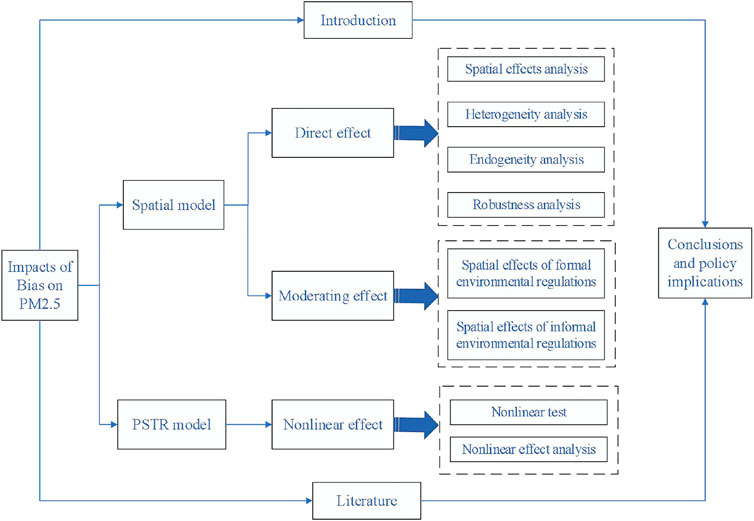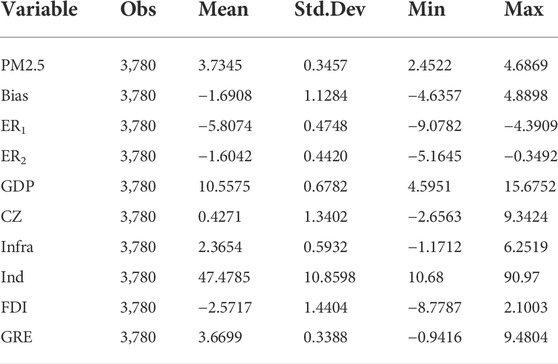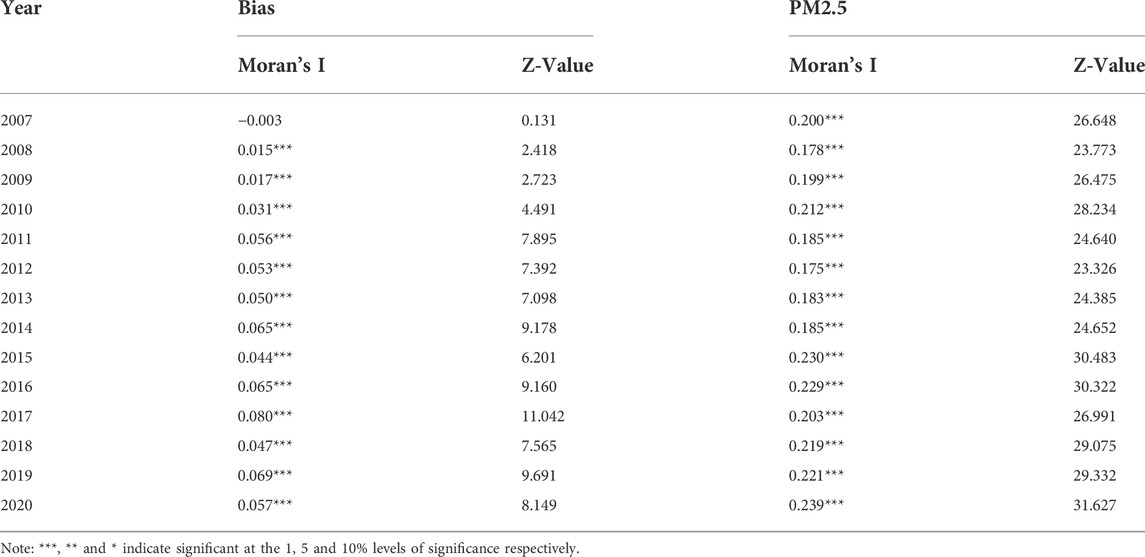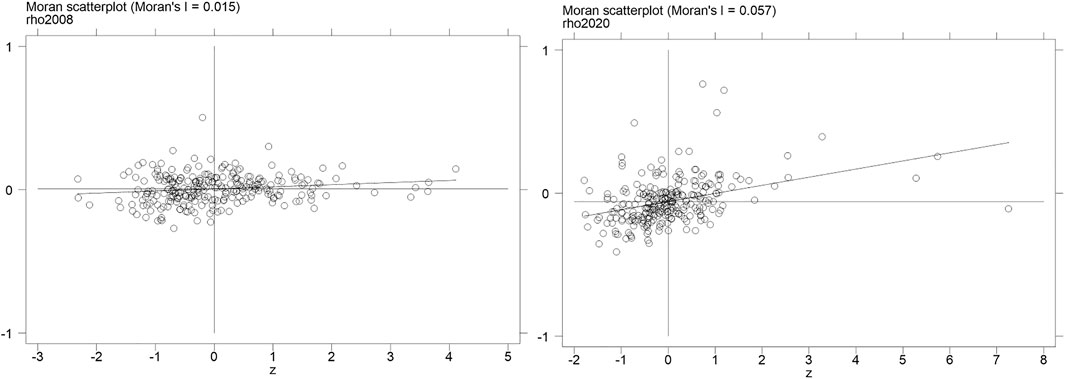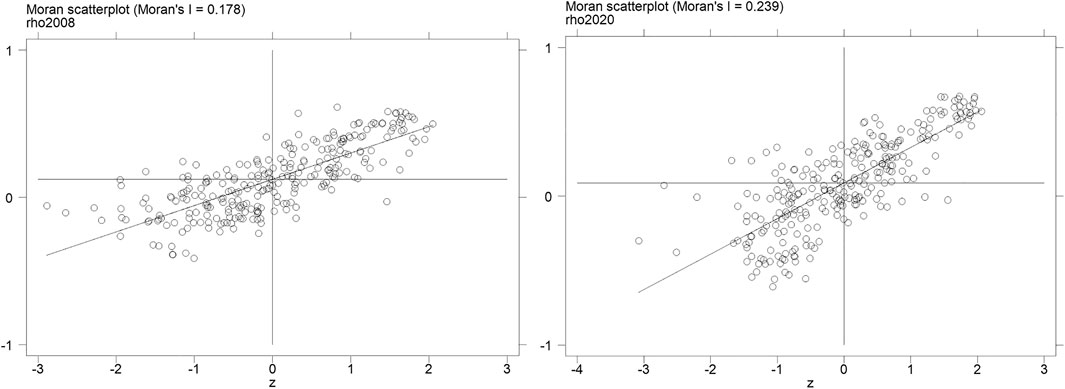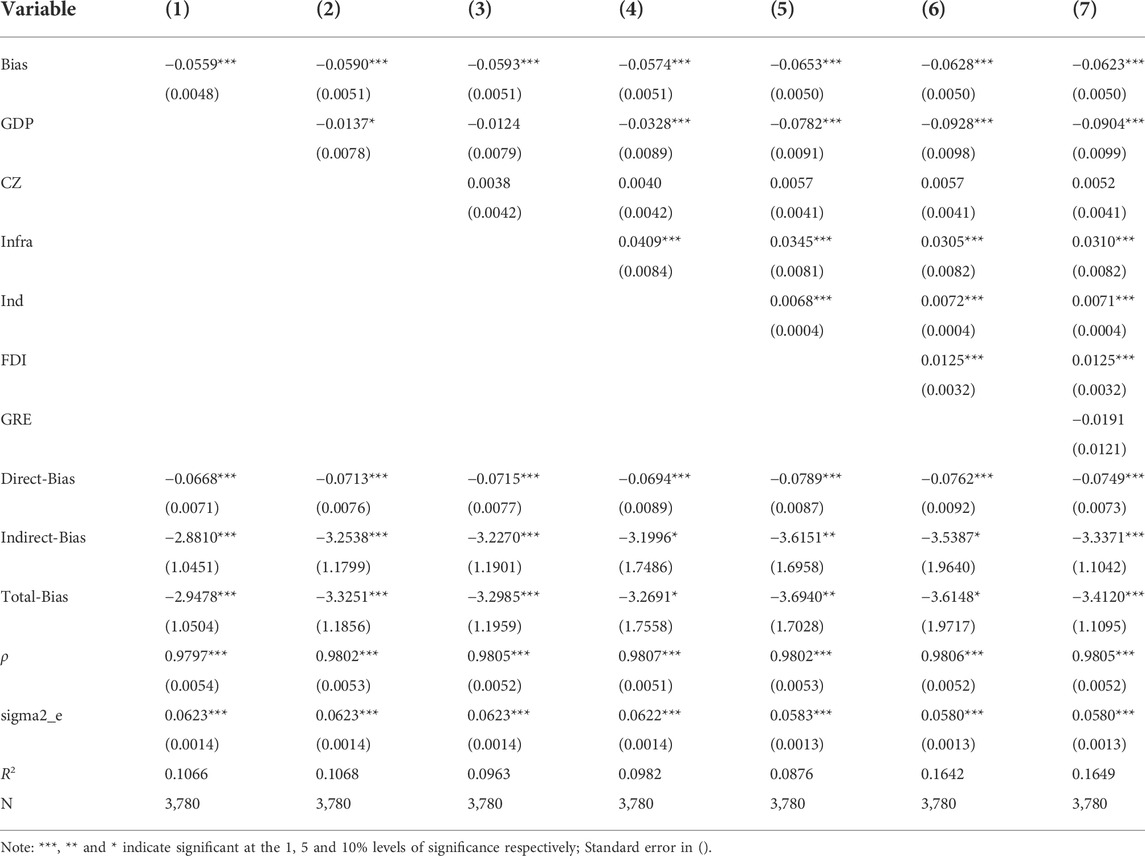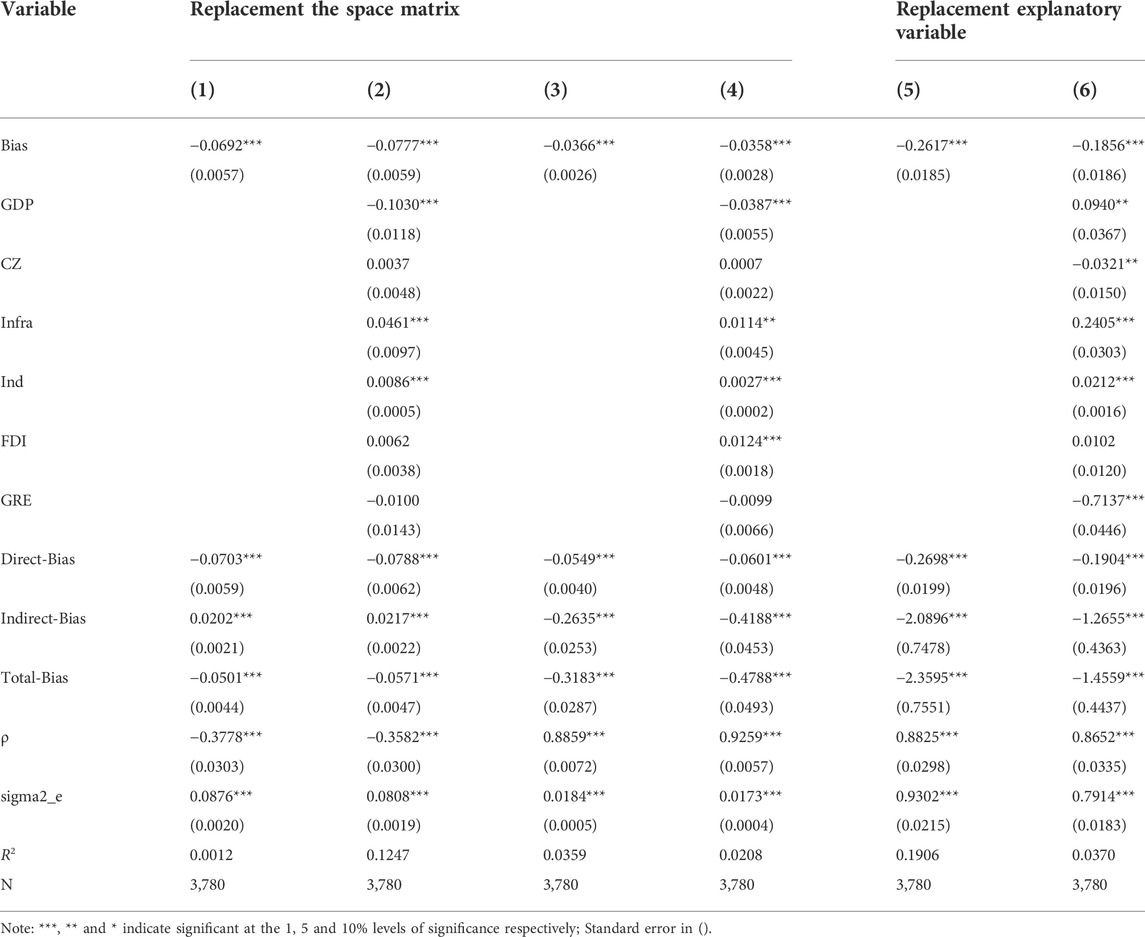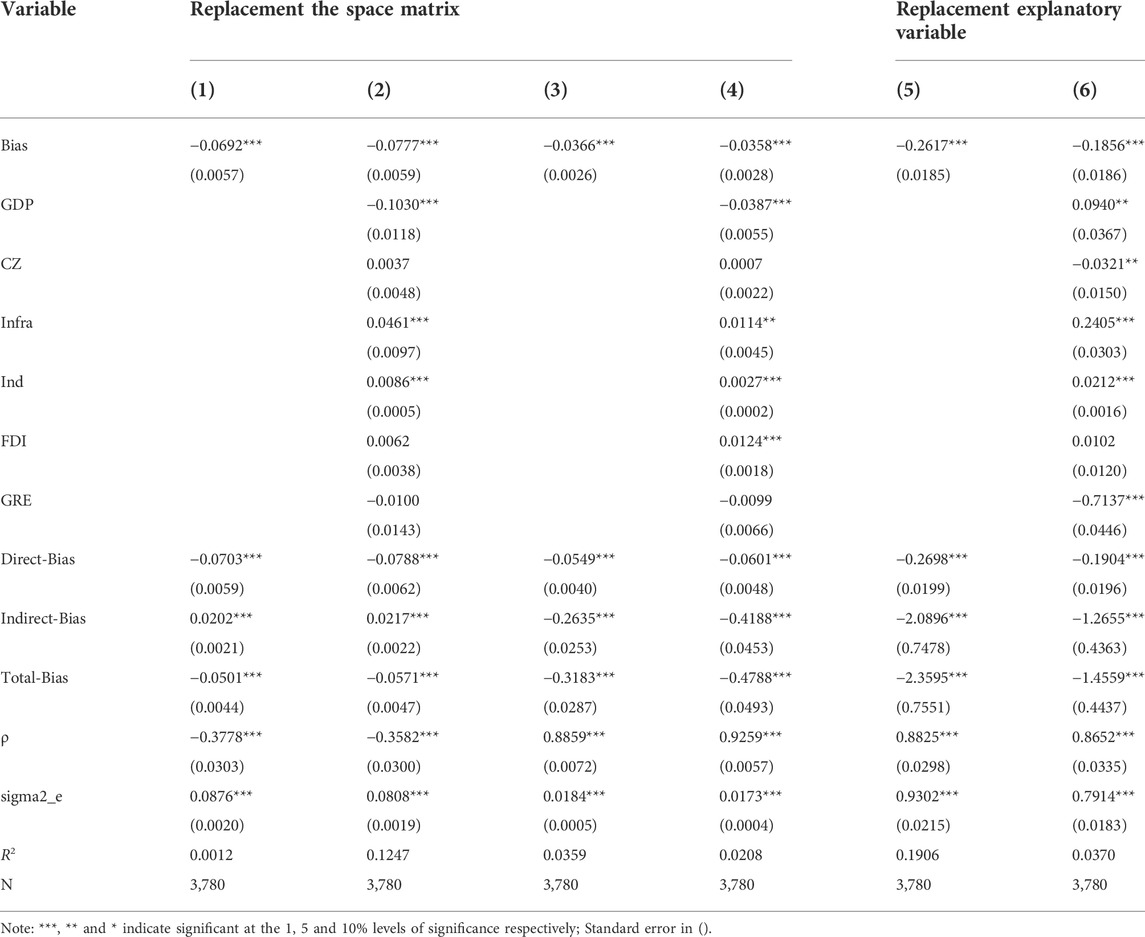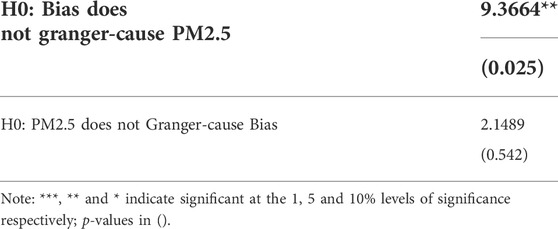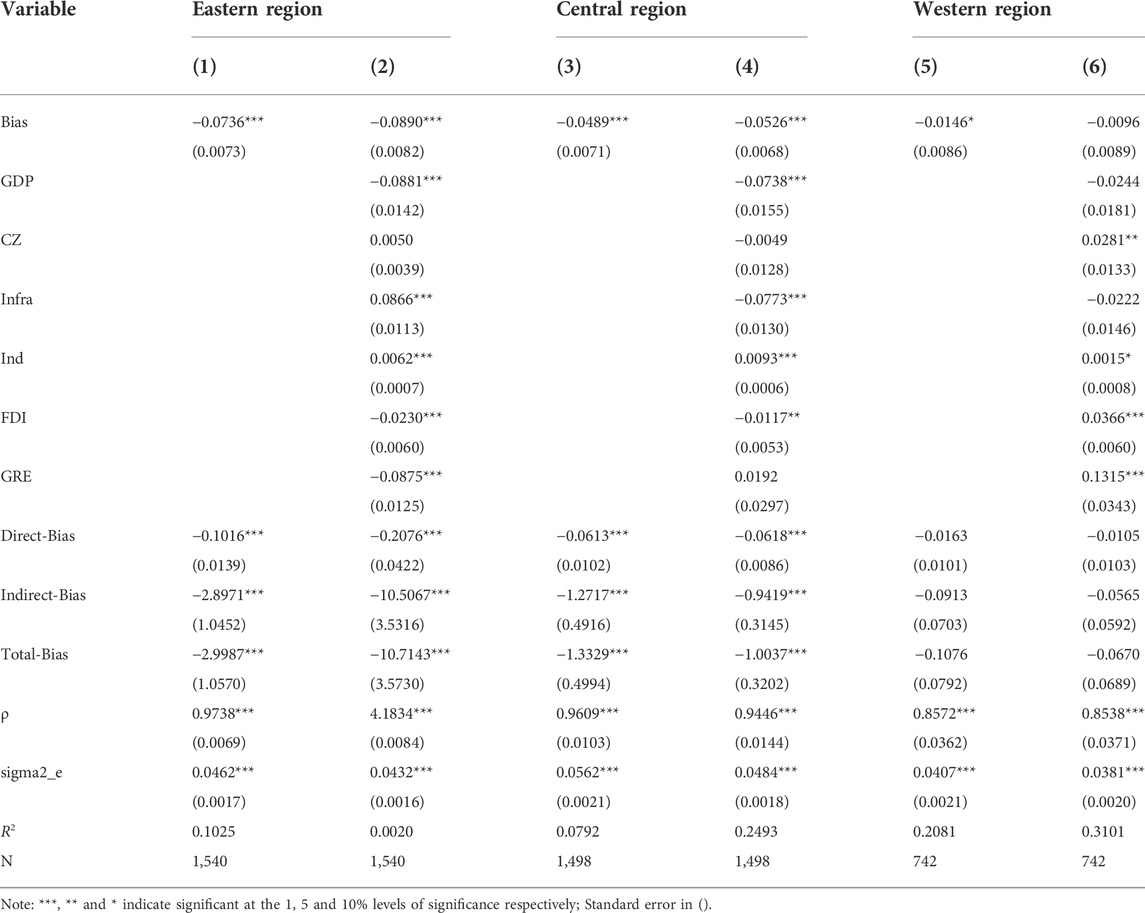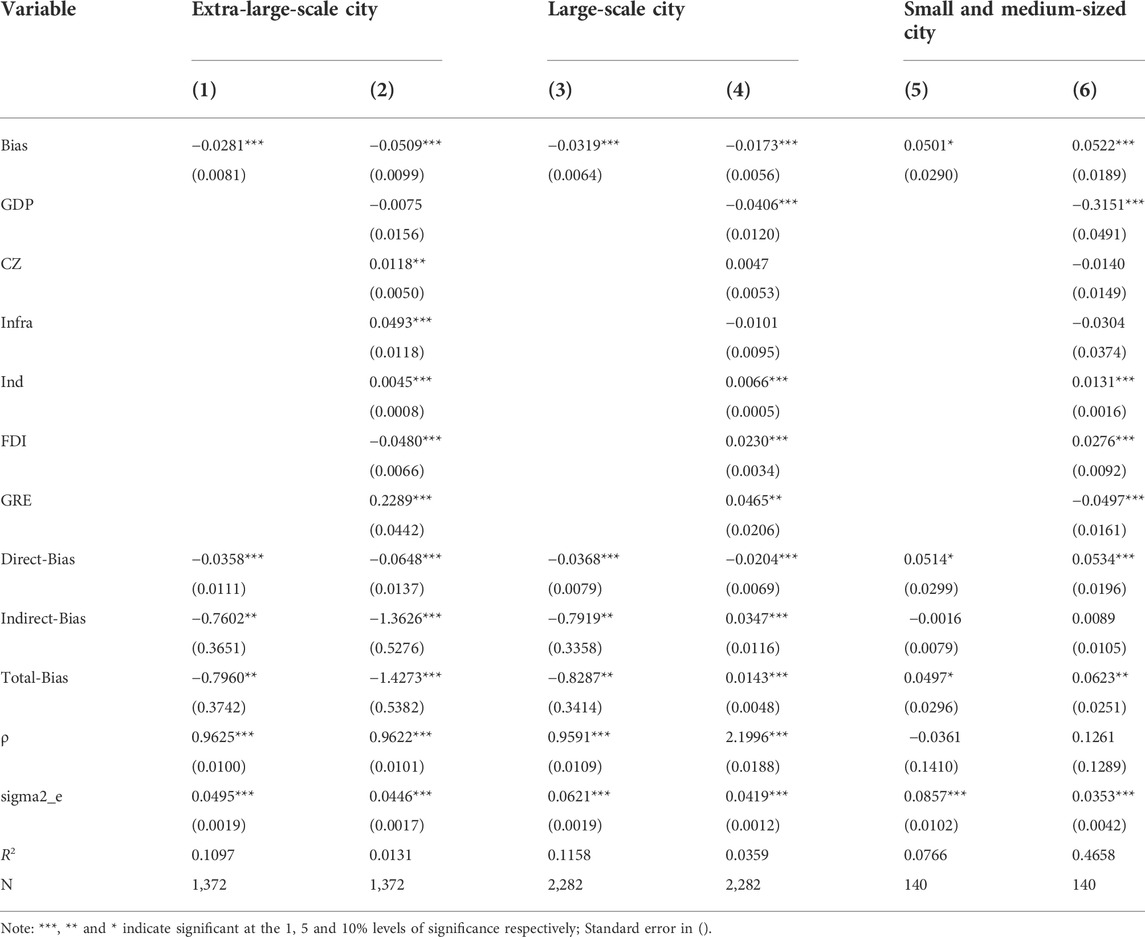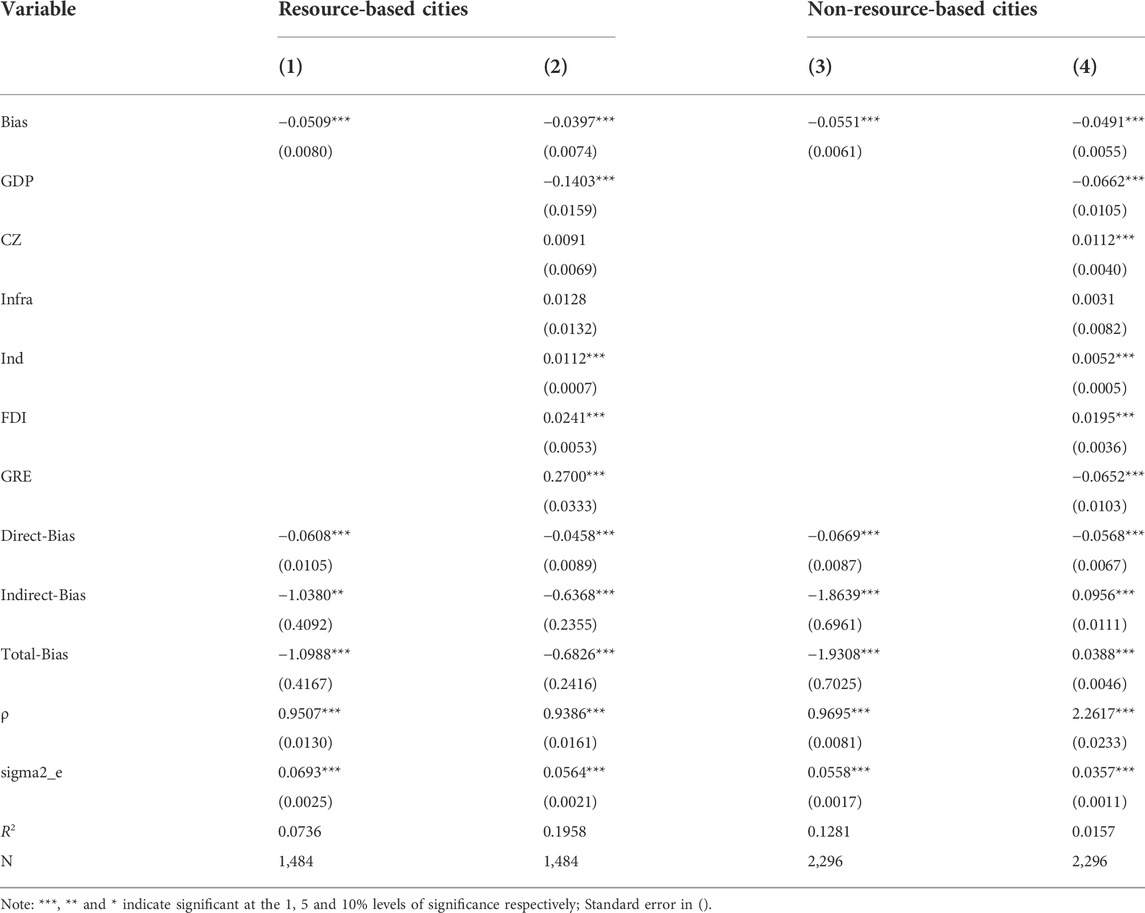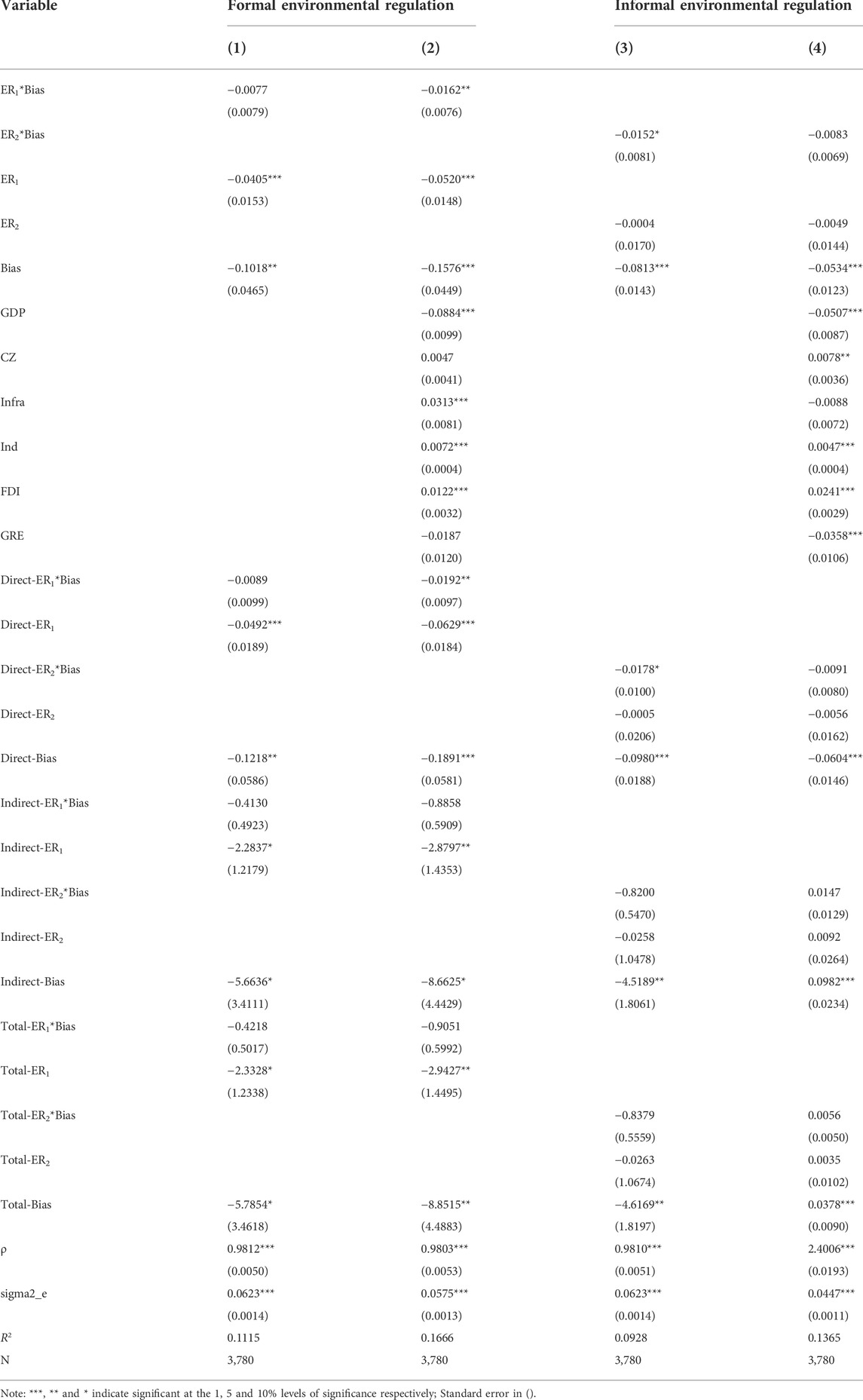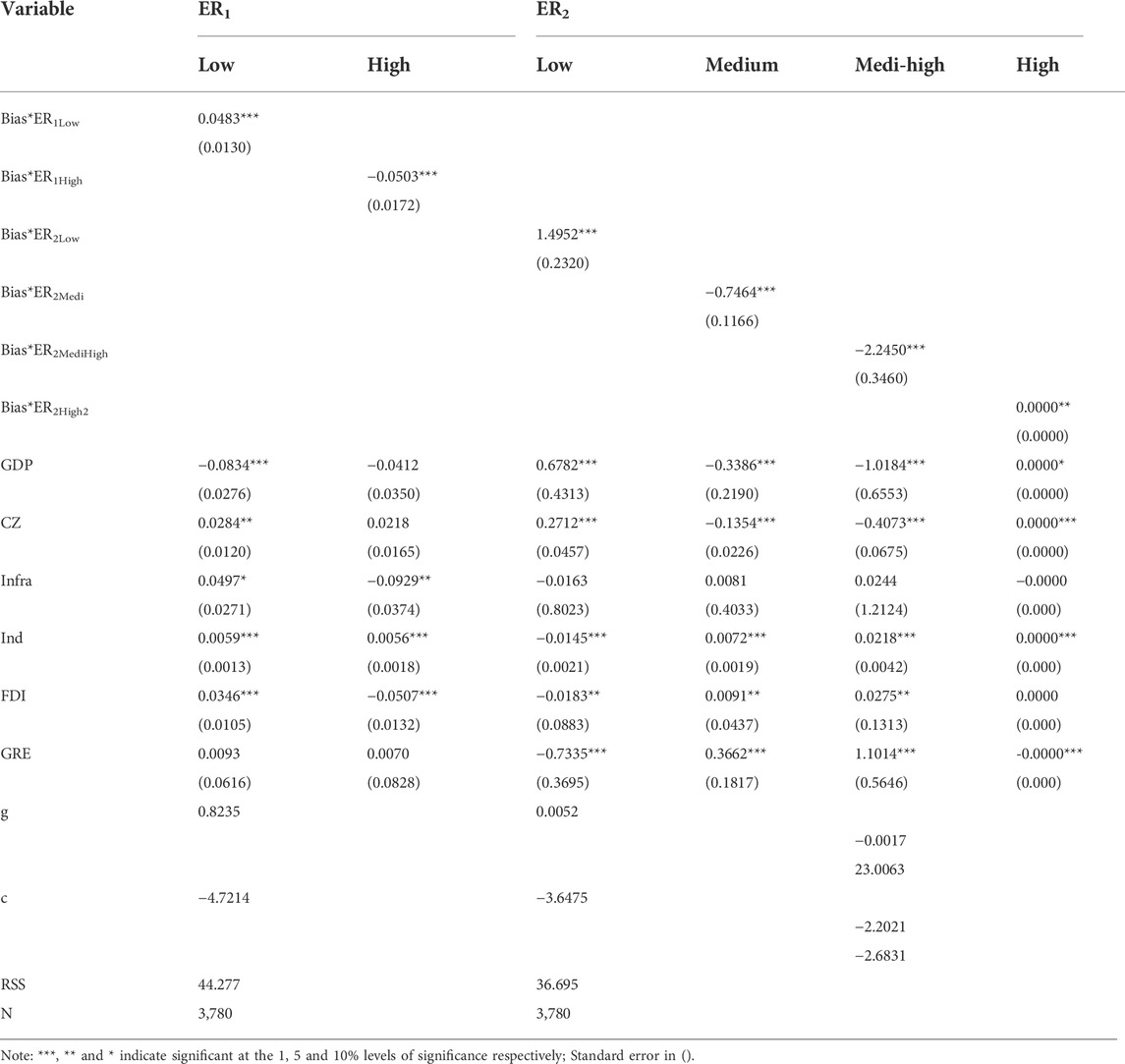- 1College of Economics and Management, Xinjiang University, Urumqi, China
- 2Center for Innovation Management Research of Xinjiang, Urumqi, China
- 3Department of Business and Economics, Shanghai Business School, Shanghai, China
Environmental policies and Environmentally biased technological advances have important theoretical value and practical significance for air pollution reduction and green economic development in China. The article is based on panel data for 270 cities in China from 2007 to 2020. Using a Spatial model, the direct, spillover and moderating effects of Environmentally biased technological progress on “local-neighbourhood” urban air pollution are examined empirically. On this basis, the PSTR model is used to further explore the non-linear effects of different types of environmental regulations. The study found that: 1) There is a significant positive spatial correlation between both air pollution and Environmentally biased technological progress in China. Environmentally biased technological progress significantly suppresses air pollution, with significant spatial spillover effects, and the conclusions remain robust after a series of robustness tests. 2) Different types of environmental regulations reinforce the dampening effect of Environmentally biased technological progress on air pollution. However, informal environmental regulation only reinforces the dampening effect of Environmentally biased technological progress on air pollution in the local cities. 3) There is a significant threshold effect of environmental regulation on the impact of Environmentally biased technological progress on air pollution. When the level of environmental regulation within a certain threshold interval, Environmentally biased technological progress has a dampening effect on air pollution. 4) The more eastern the city, the larger the city and the non-resource-based cities, the more significant the air pollution suppression effect of Environmentally biased technological advances. Based on this, this study points out that governments at all levels should pay attention to the spatial spillover effect of technological progress bias on air pollution, deepen the construction of joint prevention and control mechanisms for regional air pollution control; Establish multiple environmental regulation policies, formulate and implement environmental regulation policies according to local conditions and local technological progress bias; Formulate targeted environmental regulation policies and technological innovation policies according to the characteristics of different cities. It is an important theoretical reference to help China to fight the battle against air pollution in-depth and to promote further improvement of ecological and environmental quality.
1 Introduction
In the context of China’s pursuit of high-quality development, President Xi Jinping has called for exploring a new path oriented towards ecological priority and green development. The issue of air pollution reduction is particularly prominent and has become the main theme of green economic development (Zhao et al., 2020). The Ministry of Ecology and Environment of China released the “2021 China Ecological Environment Status Bulletin” which shows that only 218 of China’s 339 cities at prefecture level and above, or 64.3% of all cities, meet the ambient air quality standards. The annual average PM2.5 concentration is as high as 30 μg/m3, which far exceeds the standard of 10 μg/m3 in the Air Quality Guidelines issued by the World Health Organization (Chen et al., 2017). In recent years, many parts of China have been covered by extensive and prolonged hazy weather, which not only hinders the development of China’s green economy, but also endangers people’s lives and health, thus making it urgent to combat air pollution (Zhang and Wu, 2018). To this end, China has developed a number of policies to control air pollution. The Standing Committee of the 12th National People’s Congress promulgated the Law of the People’s Republic of China on the Prevention and Control of Air Pollution, which proposes to use technological advances to strengthen the comprehensive prevention and control of air pollution from coal combustion, industry, motor vehicles and vessels, dust and agriculture. The report of the 19th National Congress points out the promotion of green technology innovation, the vigorous development of green technology and the improvement of the utilization rate of resources in order to reduce air pollution. China has made “adhering to ecological priorities and technological progress leading to green development” an important strategy for achieving green economic development (Nijak, 2013). The State Council promulgated the Three-Year Action Plan to Win the Blue Sky Defense War in 2018, stating that governments at all levels should promote the joint advancement of air pollution control and air pollution reduction technologies by unleashing the power of technological innovation to ensure the ultimate victory of the Blue Sky Defense War in the shortest possible time. So in the face of China’s existing air pollution problems, technological advances are seen as an important means of addressing the air pollution challenge (Popp et al., 2010; Acemoglu et al., 2012).
Since air pollution mainly originates from energy consumption, the mechanism by which technological progress reduces air pollution is also related to the bias of technological progress towards the use of energy as a factor of production (Xiu et al., 2019). Technological progress will change the way production input factors are integrated, with different effects on different factors (Chwelos et al., 2010). Early theories of economic growth assumed that technological progress was neutral, but in reality, technological progress is biased, and it can be either resource-efficient or resource-consuming. Resource-saving technological progress can induce cities to improve and continuously increase the efficiency of integrated clean energy use to achieve the goal of green economic development (Hu et al., 2021). Therefore, in the context of China’s goal to achieve green economic development, it is important to explore the impact of biased technological advances, especially Environmentally biased technological advances, on air pollution, in order for China to make use of low-carbon technologies to fight air pollution in depth and promote further improvement of ecological and environmental quality.
Such resource-efficient technological progress is closely related to local resource endowments, especially energy, and the bias and magnitude of technological progress are uncertain (Kim, 1989). Environmental regulations imposed to protect the environment, internalise environmental costs. To a certain extent, this changes the cost and profitability of clean technology products and provides an incentive for firms to develop and use clean technologies on their own, thus breaking the pathway of technological progress to local resources and changing the direction of technological progress (Shao et al., 2020). This paper, therefore, uses environmental regulation to induce a shift from biased technological progress to cleaner production. However, different types of environmental regulations may lead to different effects of biased technological progress in reducing air pollution, and even too high or too low environmental regulations may lead to stagnation of economic growth. Is it possible then to construct an appropriate implementation strategy for environmental regulation that will have a reinforcing effect on the process of biased technological progress in curbing air pollution? In other words, is it possible to maximize the dampening effect of biased technological progress on air pollution in such an appropriate manner? The exploration of this question will facilitate local governments in formulating and implementing environmental regulatory policies by following per under local technological progress biases, which is of great significance to the in-depth fight against air pollution. Regrettably, few scholars have studied the relationship between these three.
This paper is a study of the relationship between the three. The structure of the study is as follows: Section 2 reviews the relevant literature. Section 3 conducted a theoretical analysis and makes the hypotheses. Section 4 shows the model construction and variable descriptions. Section 5 illustrates the empirical results and analyses them. Section 6 discussed the results. Section 7 provides research conclusions and Policy Implications. The research framework is shown in Figure 1.
2 Literature review
The study of the factors that contribute to air pollution reduction has been a hot topic in academia. So far, the main influencing factors include the level of economic development (Lin et al., 2014; Xie al, 2016; Jin et al., 2017; Ahmed et al., 2021), environmental regulation (Liu et al., 2021; Wang and Li, 2021; Li et al., 2022), industrial structure (Pei et al., 2021; Xue et al., 2021), transport infrastructure (Kinney et al., 2011; Lozhkin et al., 2020; Liu and Dong, 2021), technological progress (Chen et al., 2019; Wu et al., 2020; Ma et al., 2022), financial development (Yang et al., 2021; Cao Yang et al., 2022; Yang et al., 2022) and financial capacity (Kuai et al., 2019; Mahmood, 2020; Yang et al., 2022; Yin et al., 2022). Among these factors technological progress is an important means of air pollution abatement, most previous studies have focused on the impact of technological progress on air pollution abatement (Wang et al., 2019; Dong et al., 2020; Amann et al., 2020; Jahanger et al., 2022). Wang et al. (2021) highlights that technological advances can significantly reduce air pollution, but that there is variation in the reduction effect across regions. Some subsequent studies have found that technological progress has a dampening effect on air pollution to varying degrees in different industries (Fujii et al., 2013; Omri and Hadj, 2020). Some studies have also concluded that technological progress does not simply have a dampening effect on air pollution. Technological progress can lead to energy rebound effects, which can increase pollutant emissions. The dual nature of the impact of technological progress on air pollution (Sun et al., 2021; Dong et al., 2022; Yuan et al., 2022). Interestingly, the reality of production is that technological progress is biased (Hicks, 1963; Samuelson, 1965; Drandakis and Phelps, 1966). The factor ratios of capital, labour and energy, as important factor inputs to social production, are not constant. As technological progress acts, it brings about not only an increase in the efficiency of energy use but also has an impact on the efficiency of factors of production such as capital and labour. And because there is a mutual substitution relationship between different factors of production, the existence of this relationship causes a change in the ratio of demand between the factors when technological progress occurs. In other words, this biased technological progress will affect the environmental impact of factor inputs (Kennedy, 1964; Romer, 1990; Aghion and Howitt, 1992; Acemoglu, 2007).
Current research on biased technological progress focuses on the measurement of biased technological progress and the factors influencing it. There are three main approaches to measuring biased technological progress: one is the CES production function estimation method (Kiley, 1999; van et al., 2008; Klump et al., 2012). That is, by associating the production function, the profit-maximising labour first-order optimality condition and the capital first-order optimality condition with a set of three equations. The factor elasticity of substitution is estimated and the bias towards technological progress between different factors is calculated. This function assumes constant factor elasticities and strict convergence of investment rates, contrary to the laws of reality. The second is the non-parametric data envelopment (DEA) method (Song and Wang, 2018; Kang et al., 2020). This method measures total factor productivity based on DEA and further decomposes it into technical change, from which input-biased technical progress, output-biased progress and neutral technical progress are then decomposed. Although this method is not constrained by the form of the production function and avoids the resulting estimation bias, it can only determine the bias of technical progress between different factors and cannot fully reflect the extent of the bias of technical progress. The third method is stochastic Frontier models with a transcendental logarithmic (Translog) production function (Kuroda, 1988; Görgand and Strobl, 2002; Chen and Liu, 2021). This method overcomes the shortcomings of non-parametric estimation by capturing the bias in technological progress while also measuring the degree of bias. It is also more realistic to include a technical inefficiency term in the model to simulate the objective fact of efficiency loss in the actual production process of the firm. Regarding the factors influencing biased technological progress, studies found that FDI (Hale and Xu, 2016; Dong et al., 2019), energy intensity (Huang et al., 2017; Zhen et al., 2021), capital deepening (Acemoglu and Guerrieri, 2008), economic growth (Antonelli and Fassio, 2014; Jung et al., 2017), labour share (Blankenau and Cassou, 2011; Meng and Wang, 2021), finance (Bai and Li, 2018) and environmental regulation (Yang et al., 2020; Zhou et al., 2020; Cao et al., 2022) all have different degrees of influence on biased technological progress. Most scholars believe that environmental regulation can promote technological progress in favour of pollution reduction (Liu and Du, 2021), and Acemoglu et al. (2012) argues that environmental regulation can stimulate firms to undertake more R&D activities, thus promoting technological progress and total factor productivity, achieving a “win-win” situation in which environmental improvement and firm productivity increase. Some scholars argue that environmental regulation is not conducive to technological progress and is biased towards pollution reduction (Ouyang et al., 2020). The “crowding out” effect of environmental regulation makes firms invest less in productive R&D, which in turn affects their ability to improve production technology. Further research has found that the bias of environmental regulation towards technological progress in terms of pollution reduction varies by industry, province and city and may be non-linear (Liu et al., 2019).
Exploring existing research, it is easy to find that: 1) Scholars have examined the richness of research on technological progress on air pollution abatement. However, real-life technological advances are biased, and the impact and heterogeneity of technological advances based on biased emission reductions on air pollution lack in-depth exploration. 2) Most studies use the CES model and DEA model to calculate biased technological progress. However, the CES is contrary to the law of reality, and the DEA model can only determine the bias of technological progress among different elements, and cannot fully reflect the degree of bias of technological progress. In contrast, although it is more scientific to estimate technological progress using a stochastic Frontier model with a transcendental logarithmic (Translog) production function, most studies consider only two factors, capital and labour, and ignore the energy factor, which affects the environment. 3) Among the studies on the impact of biased technological progress on air pollution, there is a lack of systematic analysis from the perspective of different types of environmental regulations. Few scholars have integrated all three into the same analytical framework, and few studies have focused on spatial effects.
Therefore, the marginal contributions of this paper may lie in: 1) This study analyses the impact of environmentally biased technological advances on air pollution in a more systematic manner, and refines the study of the impact of environmentally biased technological advances on air pollution from three perspectives: geographical heterogeneity of cities, heterogeneity of city sizes and whether they are resource-based cities, reflecting the actual situation more accurately. 2) This study uses a transcendental logarithmic production function to measure environmentally biased technological progress that takes into account energy factors that affect the environment, which is closer to the practical implications of green development. 3) By constructing Spatial and PSTR models, this study systematically discusses the spatial, moderating and non-linear effects of different environmental regulations on environmentally biased technological progress and air pollution reduction, in order to help China fight the battle against air pollution in depth and promote further improvement of China’s ecological and environmental quality.
3 Theoretical analysis and research hypotheses
3.1 Direct effects of environmentally biased technological advances on air pollution
Environmentally biased technological progress can reduce air pollution emissions by changing the ratio of capital to labour, influencing the relative price of factors, and increasing total factor productivity. Firstly, Environmentally biased technological progress is accompanied by innovation and replacement of machinery and equipment, changing the ratio of capital labour allocation and optimising the industrial structure to curb air pollution emissions (Acemoglu et al., 2012). According to the Cobb-Douglas production function, capital and labour are the two essential factors of production in the production process, and a relatively high price of a certain factor will lead to economic development that will prompt production units to undergo technological innovation in this factor of production, and technological progress will be biased (Takayama, 1974). Environmentally biased technological progress allows for a change in the ratio of factor inputs of energy and labour, promoting an optimal upgrading of the industrial structure (Song and Wang, 2016). The optimization of the industrial structure will gradually reduce air pollution emissions by reducing the proportion of highly polluting industries, promoting the development of high-tech industries, service industries and other low-polluting industries, and promoting the rational allocation and recycling of factor resources. As the centre of economic development gradually shifts from primary and secondary industries to secondary and tertiary industries, clean and green production processes, pollutant treatment equipment and green and renewable energy will be introduced into the production process, thus contributing to the reduction of air pollutant emissions and the improvement of ecological and environmental management (Zheng et al., 2020). Secondly, Environmentally biased technological progress changes the relative prices of factors by influencing changes in the supply and demand in factor markets, thereby affecting the ratio of factor inputs and the scale of output to reduce air pollution emissions (Acemoglu et al., 2014). Changes between energy and labour factor inputs as a result of the technological progress bias can affect the amount of energy consumed and thus air pollution emissions. Changes in factor input ratios can cause changes in the relative prices of factors. The number of inputs will reduce the relative prices of factors, and technological progress will further bias the lower-priced factors, affecting changes in air pollution emissions. As resources become increasingly scarce, factor prices rise (Hall and Hall, 1984). Firms need to increase factor output in order to save costs and increase their profitability, causing them to expand production to achieve economies of scale. This leads to resource conservation, which reduces the cost of production and operation due to higher energy factor prices, allowing firms to invest more in product research and development and reduce their air pollution emissions (Jaramillo and Muller, 2016). Finally, Environmentally biased technological advances reduce air pollution emissions by increasing total factor productivity and reducing resource consumption (An et al., 2020). Environmentally biased technological advances introduce green processes at the beginning of production to reduce air pollution emissions by replacing traditional fossil fuels with clean fuels, optimising production processes and improving the efficiency of the use of resources such as water and electricity (Yasmin and Grundmann, 2019); During the production and processing process, technological advances improve resource utilisation, save natural resources and fossil energy inputs, and reduce air pollution emissions. At the end of consumption, green product innovation can reduce the amount of waste generated during and after the consumption of products and facilitate the recycling of used items, thus technological progress is biased towards reducing environmental pollution (Purushothaman et al., 2021). In addition, cities act as important spatial vehicles for factor mobility, facilitating the movement of resources between regions. The technological progress bias directly influences the share of factor allocation through substitution or complementary relationships between factors, thus affecting the level of air pollution that flows across regions. The spatial properties of urban geography dictate that the impact of Environmentally biased technological progress on air pollution will inevitably have a spatial spillover effect, thus affecting neighbouring cities.
Accordingly, this paper proposes the following hypothesis.
Hypothesis H1:. Environmentally biased technological advances can curb air pollution emissions and have spatial spillover effects.
3.2 Moderating effects of environmental regulation on environmentally biased technological progress and air pollution
As a trigger for Environmentally biased technological progress, environmental regulation can change the direction of technological progress, steering it in the direction of cleanliness and helping to reduce air pollution emissions (Porter and Van der, 1995). Firstly, environmental regulation influences Environmentally biased technological progress by adjusting the ratio of factor demand to curb air pollution emissions (Jaffe et al., 2002). Environmental regulation creates new demands on firms, which may be in the form of the introduction of emissions equipment, the absorption of pollution control personnel, etc. This compliance input has Environmentally biased technological advances in companies toward reducing air pollution emissions. When a region has a distinct factor endowment, technological progress tends to favour the use of abundant factors to save scarce factors of production. Environmental regulation in fact restricts the use of highly polluting factors in regional production, artificially altering the factor endowment of the region. Not all factors can be used without restraint. Thus, when environmental regulation enhances the ability of technology to couple with capital, labour, energy and intermediate goods, it adapts technological progress to the factor endowments used in production. This explores the optimal way for technological progress to reduce air pollution (Xu and Xu, 2021). Second, environmental regulation affects the role of Environmentally biased technological progress on air pollution emissions by increasing the prices of factor inputs (Gray and shadbegian, 2003). Increases in the price of an energy factor Environmentally bias technological progress towards the conservation of that factor or towards the use of improved and cleaner energy sources as substitutes for fuel. These measures directly impose additional costs and burdens on polluters or firms, increasing transaction and decision costs, which in turn trigger a shift in technological progress towards something that will reduce that cost (Kennedy, 1964). Companies have made technological advances biased towards reducing the cost of corporate emissions for their own competitiveness. Under environmental regulation, the barriers to entry for firms are raised and each firm pays a price for compliance. However, this cost is not the same, and the cost is smaller for companies that respond promptly or have good pollution prevention mechanisms. For some non-polluting companies, even this compliance cost is zero. This creates relative differences in competitiveness between firms, leading to technological innovation in the search for new competitiveness, and inducing technological progress in the direction of reducing air pollution (Shadbegian and Gray, 2005). Finally, environmental regulation inhibits air pollution emissions through the technological bias induced by resource efficiency (Hamamoto, 2006). Improving environmental quality makes firms demand higher resource efficiency, and this makes the aim of improving resource efficiency an incentive for firms to innovate and thus induce Environmentally biased technological progress (Cao et al., 2020). When resource and environmental policies, such as environmental regulations, are strengthened, enterprises are induced to enhance the introduction of carbon-reducing technologies and the development of cleaner production technologies, thus inducing technological progress in favour of resource and energy conservation. This is conducive to more efficient energy use and lower air pollution emissions. As an important tool for the government to address environmental issues and achieve green economic development, environmental regulation, in combination with energy-biased technological advances, is one of the two main drivers of China’s commitment to energy conservation and emission reduction, and the solid promotion of the Blue Sky Defence.
Accordingly, this paper proposes the following hypothesis.
Hypothesis H2:. Environmental regulation reinforces the dampening effect of Environmentally biased technological progress on air pollution emissions.
3.3 Analysis of the nonlinear effect of environmental regulation
Most scholars argue that environmental regulation induces a transition from environmentally biased technological progress to cleaner production, while some argue that the “crowding out effect” of environmental regulation causes a “rebound effect” on firms. That is, environmental regulation hinders technological progress in favour of pollution reduction (Yang and Li, 2017). On the one hand, there is often a long time lag between the application of innovations resulting from environmental regulation to the production practices of enterprises. It is difficult to show the impact of innovations on the technological level, energy efficiency and management efficiency of enterprises in a short period of time; On the other hand, technological improvements brought about by environmental regulations push companies to expand their production. This leads to more energy consumption, which in turn causes more serious environmental problems (Fan et al., 2021). Whether environmental regulation promotes technological progress and contributes to pollution reduction is closely related to the type of policy it is and how strongly it is enforced. In terms of type, environmental regulation is divided into formal environmental regulation and informal environmental regulation. Formal environmental regulation refers to the various means by which governments regulate environmental resources. The local government has significantly reduced air pollution emissions through energy efficiency subsidies, environmental taxes and fees (Zhou et al., 2019). In contrast, neighbouring regions are not as strongly influenced by local environmental policies, and the benefits of energy efficiency subsidies and environmental taxes will not allow the expected benefits of green technology innovation to cover their costs, making formal environmental regulation of air pollution reduction less effective. Informal environmental regulation refers to environmental regulation that relies on public participation as society becomes more environmentally aware. There is no systematic and dedicated long-term support from local citizens to monitor the environment, resulting in an effect that is not significant, although there is some reduction in emissions. Public participation in environmental regulation tends to have a bias towards technological progress in neighbouring areas for a longer period of time, during which time it may not be effective in reducing air pollution. Therefore, different types of environmental regulation can lead to different effects of environmentally biased technological advances in reducing air pollution. It is relevant to identify appropriate environmental regulation implementation strategies that will show greater effectiveness in curbing environmentally biased technological advances in air pollution.
Accordingly, this paper proposes the following hypothesis.
Hypothesis H3:. There may be a threshold effect of environmental regulation, i.e., there may be optimal intervals for environmental regulation to make Environmentally biased technological progress to curb air pollution emissions.
4 Model construction and variable description
4.1 Model construction
4.1.1 Construction of the spatial panel model
PM2.5 is diffusivity and is influenced by wind direction and climatic conditions to achieve spatial mobility, with a strong correlation effect in space (Mahmood, 2022). Traditional econometric models, on the other hand, are mostly “mean reversion”, which are susceptible to extreme values and assume that the objects of study are independent of each other (Mahmood, 2022). In reality, everything is often spatially correlated, and ignoring spatial correlation can lead to biased estimates (Baltagi and Li, 2014). Therefore, this paper draws on Anselin’s (1988) research methodology to construct a spatial econometric model to reveal the impact of Environmentally biased technological progress on air pollution research. The general equation of the SAR econometric model is set as follows:
where (1),
The above equation tests the direct effect of Environmentally biased technological progress on air pollution. This paper draws on Baron and Kenny (1986) and introduces an interaction term between environmental regulation and Environmentally biased technological progress to further examine the moderating effect of environmental regulation on Environmentally biased technological progress and air pollution, with the moderating effect model set as follows:
4.1.2 Construction of the spatial weight matrix
The spatial weight matrix also needs to be constructed when introducing a spatial measurement model. Spatial weight matrices are used to characterise the interconnections and dependencies between spatial units (Qu and Lee, 2015). The selection of an appropriate spatial weight matrix in a study is crucial in exploring the spatial impact of Environmentally biased technological advances on air pollution. The spatial distance weight matrix is based on the geographical distance between regions, which is in line with the “first law of geography”, where things are linked to other things, but more closely to things that are closer together. Therefore, this paper draws on the method of Han et al. (2018) and others, and adopts the idea of the gravitational model to construct the spatial weight matrix set as follows:
Where
4.1.3 Construction of PSTR model
According to the theoretical hypothesis, it is assumed that the effect of different types of environmental regulations on the suppression of Environmentally biased technological progress and air pollution will be different. To explore the optimal interval of different environmental regulations, so that Environmentally biased technological progress has been showing a strengthening effect in the suppression of air pollution. Drawing on Gonzalez (2017), PSTR model with environmental regulation as the transformation variable was constructed with the MATLAB software. The model was constructed as follows:
Of which,
4.2 Description of variables
4.2.1 Explanatory variables
Air pollution (PM2.5). PM2.5, as the main component of air pollution, has a serious impact on economic development, and seriously endangers human health and quality of life. In this paper, PM2.5 concentration (μg/m3) is chosen to characterise air pollution indicators. Drawing on the methodology of Guo et al. (2021), data from the Atmospheric Composition Analysis Group (ACAG) of Dalhousie University, Canada, were used. The data were analyzed using geographically weighted regression (GWR) from NASA satellites and ground-based monitoring stations after a comprehensive assessment of the latitude and longitude raster data, and then using ArcGiS software to resolve the average PM2.5 concentrations from global satellite data for 270 prefecture-level cities in China. When the PM2.5 concentration is higher, it indicates that urban air pollution emissions are more serious.
4.2.2 Core explanatory variables
Environmentally Biased technological progress (Bias). The beyond logarithmic production function model reflects the cumulative factor effects and scale effects. It is more robust, accurate and realistic than the CES production function. In contrast, the DEA model only reflects the bias of technological progress but does not represent the degree of factor bias. Therefore, this paper draws on Wei et al.’s (2019) study and adopts the beyond-log production function model to measure biased technological progress, with the following equation:
Equation 5,
According to Eq 5, the three output elasticities of capital, labour and energy can be obtained as:
4.2.3 Transformation variables
1) Formal environmental regulation (ER1): this paper draws on Luo et al. (2019). First, the government work reports of 270 cities from 2007 to 2020 were collected manually. Then the government work report texts were word-sorted to count the frequency of environment-related words and calculate their proportion of the total word frequency of the full government reports. The final indicator of formal environmental regulation for each city was obtained. The size of the index reflects the importance that each prefecture-level city government attaches to environmental pollution issues. The higher the value, the greater the intensity of formal environmental regulation.
2) Informal environmental regulation (ER2): Informal environmental regulation mainly emphasizes the impact of people’s environmental awareness on environmental quality. Drawing on Pargal and Wheeler‘s (1996) study, this paper uses the entropy method to calculate a composite indicator of three variables, namely income level, population density and education level, to measure informal environmental regulation. The level of education, measured by the proportion of the total number of primary, secondary and tertiary teachers in the total population in the city, the higher the level of education the more environmentally aware the group is; the level of income, measured by the average wage of urban workers on the job, the higher the income level the higher the public demand for environmental quality in the area; the population density, measured by the population density of the municipal district, the higher the population density in the city means the more polluted the population is and therefore more public opposition to these polluting enterprises. The higher the value of the composite indicator, the greater the intensity of informal environmental regulation.
4.2.4 Control variables
Level of economic development (GDP). As there are many studies on EKC. The relationship between income level and environmental pollution shows an “inverted U″ curve, suggesting that economic development is also closely related to air pollution. Refer to Yuan et al. (2015). Using the ratio of total production to total population at the end of the year in the city. 2) Fiscal capacity (CZ). Drawing on the study by Yang et al. (2021), measured the ratio of urban local fiscal general budget revenues to local fiscal general budget expenditures. 3) Level of infrastructure (Infra). Referring to CHEN et al. (2018), this paper uses the ratio of urban paved road area to population to measure the level of infrastructure. When the area of paved roads per capita is larger, the infrastructure is higher. 4) Industrial structure (Ind). Air pollution emissions are mainly associated with the industrial sector, which is part of the secondary industry. Therefore, drawing on the study by Cheng et al. (2017), the total production of the secondary industry as a percentage of the total production of the total industry was used as a measure in %. 5) Level of openness to the outside world (FDI). Current research shows that the direction of FDI on environmental quality is not yet clear. The “pollution halo” hypothesis suggests that FDI can bring about improvements in environmental quality through the introduction of environmentally friendly technologies and products, while the “pollution shelter” hypothesis suggests that through the transfer of highly polluting industries, FDI will cause environmental degradation in the host country. The “pollution shelter” hypothesis suggests that FDI will degrade the environment in the host country through the transfer of highly polluting industries. This paper draws on Cheng et al. (2020) to examine the role of FDI in haze pollution in China, using a measure of FDI as a proportion of GDP. Where FDI is the actual amount of foreign capital utilised (USD million) multiplied by the average exchange rate to obtain the actual amount of foreign capital utilised (RMB: million) measure. 6) Urban greening level (GRE). Drawing on the study by Li et al. (2021), the greening level of cities is measured using the greening coverage of built-up areas. When the greening coverage of the built-up area is higher, it indicates the higher greening level of the city.
4.2.5 Data description and descriptive statistics
This paper uses panel data for 270 prefecture-level cities in China for the period 2007–2020. The data were obtained from the China Statistical Yearbook, the China City Statistical Yearbook, the statistical yearbooks of each city in previous years, the EPS database and the CSMAR database. All variables were treated by taking logarithms, except for industrial structure indicators. For some of the missing data, interpolation was used to fill in the gaps. The descriptive statistics of the variables are shown in Table 1.
5 Empirical results and analysis
5.1 Spatial correlation test
When exploring the impact of environmentally biased technological progress on air pollution through spatial model, it is first necessary to test whether the core variables are spatially correlated. The Moran’s I is used to measuring the correlation and aggregation state of the space, with a range of values of (−1,1) (Mahmood and Furqan, 2021). Moran’s I value greater than 0 indicates a positive correlation between spatial units, indicating spatial agglomeration. Moran’s I value of less than 0 indicates a negative correlation between spatial units, manifesting as spatial diffusion. Moran’s I value equal to 0 indicates no correlation between spatial units (Gaver et al., 1992). Therefore, this study uses Moran’s I to explore the spatial correlation between Environmentally biased technological progress and air pollution. The Moran’s I is divided into a global Moran’s I and a local Moran’s I. The results of the global Moran’s I are shown in Table 2. Under the geographic distance weight matrix, Moran’s values for both Environmentally biased technological progress and air pollution are significantly positive, indicating that spatial units of similar nature are clustered, strongly rejecting the original hypothesis of “no spatial correlation” and satisfying the prerequisites for spatial econometric analysis.
The local Moran’s I can reflect the spatial clustering in the vicinity of an area. In order to get a clearer picture of the spatial correlation between regions, this paper calculates the local Moran’s I for each year of the sample period under a geographical distance weighting matrix (Mahmood et al., 2020). The results also indicate the existence of a spatial correlation between Environmentally biased technological progress and air pollution. Figures 2, 3 show the Moran scatter plots for Environmentally biased technological progress and air pollution in 2008 and 2020 respectively. As can be seen in Figure 2, the vast majority of cities fall in quadrants one and three, indicating that there is a positive spatial correlation between Environmentally biased technological progress, with cities with high Environmentally biased technological progress being surrounded by high-value cities and cities with low Environmentally biased technological progress being surrounded by low-value cities, with increasing spatial correlation. As can be seen from Figure 3, most cities are located in the first and third quadrants, and air pollution is also characterised by high and low clustering, with increasing spatial correlation. From the above analysis, it can be concluded that there is a positive spatial correlation between both Environmentally biased technological progress and air pollution, and if this spatial correlation is ignored, it will lead to biased measurement results.
5.2 Model setting tests
According to Elhorst (2014), the model selection principle of “from specific to general” and “from general to specific” was combined. The results of the mixed OLS test, LM test, Hausman test are shown in Table 3. Moran’s I is significantly, indicating that the spatial econometric model is better than the OLS model and the choice of spatial econometric model is reasonable. Hausman’s test results indicate that the model setting should use a fixed effects model. The LM-lag test and LM-lag (robust) test are significant at the 1% level, but LM-error test and LM-error (robust) test are not significantly. Therefore, the SAR model was chosen for the regression analysis in this paper.
5.3 Analysis of benchmark regression
5.3.1 Direct effects regression results
In this paper, an empirical analysis was conducted using the SAR model, and regressions on Environmentally biased technological progress and air pollution were conducted by adding control variables one by one, and the results are shown in Table 4. In terms of the spatial effect term for air pollution, the
In terms of the control variables, our main reference is shown in column (7). The coefficient of the level of economic development is negative at the 1% significance level, indicating that a higher level of economic development in a city will suppress air pollution; The coefficient of financial capacity is positive, indicating that a stronger level of financial capacity in a city will promote urban air pollution; The coefficient of infrastructure is significantly positive, indicating that a higher level of infrastructure in a city will promote air pollution; The coefficient of industrial structure is significantly positive, indicating that the higher the share of secondary industry will promote air pollution; The coefficient of foreign direct investment is significantly positive, indicating that the higher the level of foreign investment in the city will promote air pollution; The coefficient of urban greening level is negative, indicating that the higher the level of urban greening will suppress air pollution emissions.
5.3.2 Robustness test
In order to analyse the accuracy of the conclusions obtained under the full sample conditions described above, this paper applies the following two methods to test the robustness of the results, as shown in Table 6. First, the method of replacing the spatial matrix is adopted. Columns (1)–(2) are the economic weight matrices, calculated using the inverse of the absolute value of the difference in GDP per capita between the two cities; Columns (3)–(4) are the 0–1 weight matrices, with 0 for neighbouring cities and 1 otherwise. The estimated results show that the coefficients of Environmentally biased technological progress are all negative at least at the 1% level of significance, indicating that the above regression results are robust. Second, the approach of replacing the explanatory variables was adopted. The explanatory variable PM2.5 was replaced with sulphur dioxide emissions (SO2) above, while the rest remained the same as above. The results are shown in columns (5)–(6), and the coefficients of the Environmentally biased technological progress are all negative at least at the 1% significance level, indicating the robustness of the regression results above.
5.3.3 Endogenous test
It is clear from the previous section that Environmentally biased technological progress has a significant inhibitory effect on urban air pollution. Although the factors affecting air pollution are included in this paper, there is a possibility that other influencing factors may be omitted leading to endogeneity problems and bias in the estimation. To obtain more reliable estimates, a panel Granger causality test was used to further confirm the existence of reverse causality. The estimated results are shown in Table 7. In testing whether Environmentally biased technological progress is a Granger cause of air pollution, a significance level of 5% was passed. And when testing whether air pollution is the Granger cause of Environmentally biased technological progress, a confidence level of 10% was not reached. As can be seen, the results based on the panel Granger causality test also support that there is no significant endogeneity problem between the core explanatory variables and the explanatory variables in this paper.
5.3.4 Heterogeneity analysis
5.3.4.1 Geographical heterogeneity
China is a vast country, and regression analysis based on the total sample of cities may mask regional differences. Therefore, this paper divides the urban panel data into eastern, central and western regions according to different geographical locations to examine the differential impact of Environmentally biased technological progress on air pollution. As shown in Table 8, the impact of Environmentally biased technological advances on reducing air pollution was significantly higher in Eastern Region (8.90%) than in Central Region (1.73%). In Western Region, Environmentally biased technological advances have a insignificant negative to air pollution.
5.3.4.2 City size heterogeneity
According to the Notice of the State Council on Adjusting the Criteria for Classifying City Size, cities with a population of less than 1 million are classified as small and medium-sized cities, cities with a population greater than or equal to 1 million and less than 5 million are classified as large-scale cities, and cities with a population greater than 5 million are classified as extra-large-scale cities, using the resident population in 2014 as the criterion. Therefore, this paper classifies urban panel data into extra-large-scale cities, large-scale cities and small and medium-sized cities according to different city sizes, and examines the differential impact of Environmentally biased technological progress on air pollution. As shown in Table 9, the impact of Environmentally biased technological advances on reducing air pollution was significantly higher in Extra-large-scale-cities (5.09%) than in Large-scale cities (1.73%). In contrast, in small and medium-sized cities, Environmentally biased technological advances have a significant positive contribution to air pollution.
5.3.4.3 Heterogeneity of whether it is a resource-based city
The cities were divided into resource-based and non-resource-based cities according to the National Sustainable Development Plan for Resource-based Cities (2013–2020) issued by the State Council to examine the differential effects of examining Environmentally biased technological advances on air pollution. The results are shown in Table 10. The impact of Environmentally biased technological advances on air pollution is significantly negative in both resource and non-resource cities. However, the effect was better in non-resource cities.
5.4 Interaction impact regression results
To examine whether environmental regulation strengthens the inhibitory effect of Environmentally biased technological progress on air pollution. So the cross-multiplication term between environmental regulation and Environmentally biased technological progress was added and the regression results are shown in Table 11. Columns (1)–(2) are the regression results of Environmentally biased technological progress on air pollution under formal environmental regulation. Columns (3)–(4) are the regression results of Environmentally biased technological progress on air pollution under informal environmental regulation. The cross-products of both formal environmental regulation and Environmentally biased technological progress are significantly negative at the 5% level; The cross-products of both informal environmental regulation and Environmentally biased technological progress are negative. This suggests that environmental regulation reinforces the dampening effect of environmentally biased technological advances on air pollution emissions. This verifies hypothesis H2. The spatial effect term ρ for air pollution is still significantly positive at the 1% level, indicating that the spatial spillover characteristics of air pollution still exist. The direct effect of the interaction term between formal environmental regulation and environmentally biased technological progress is significantly negative, indicating that formal environmental regulation significantly enhances the dampening effect of environmentally biased technological progress on air pollution in the region; Indirect effects are negative, indicating that formal environmental regulations significantly enhance the dampening effect of environmentally biased technological advances on air pollution in neighbouring areas. The direct effect of the interaction term between informal environmental regulation and environmentally biased technological progress is negative, indicating that informal environmental regulations enhance the dampening effect of environmentally biased technological progress on air pollution in the region; The indirect effect is insignificantly positive, suggesting that informal environmental regulation weakens the dampening effect of environmentally biased technological progress on air pollution in neighbouring areas, but not to a significant degree.
5.5 PSTR model regression results
5.5.1 Non-linearity test
In order to investigate the optimal interval of environmental regulation on Environmentally biased technological progress affecting air pollution, this paper uses the PSTR model for validation. Before proceeding with the estimation of the PSTR model, the model needs to be tested for non-linearity. As shown in Table 12, the study found that: The original hypothesis H0: r = 0 is rejected for the LM, LMF and LRT tests in the ‘non-linearity test’, regardless of whether formal or informal environmental regulation is in place. This suggests a non-linear influence of environmental regulation in the process by which Environmentally biased technological advances affect air pollution. When examining the number of r’s in the “residual non-linearity test”, the LM, LMF and LRT test values in the formal environmental regulation reject the alternative hypothesis H1: r = 2, and the number of optimal transition functions is 1. The LM, LMF and LRT test values in informal environmental regulation all reject the alternative hypothesis H1: r = 4, and the number of optimal transition functions is 3.
5.5.2 Estimated results
As shown in Table 13, when formal environmental regulation is used as the conversion variable, a conversion function exists for the model. The conversion function is divided into low and high zones by the location parameter c (-4.7214). The estimated coefficient of 0.0483 for Environmentally biased technological progress in the low zone indicates that Environmentally biased technological progress has a significant positive impact on air pollution when formal environmental regulation is below the threshold of -4.7214; The estimated coefficient of -0.0503 for Environmentally biased technological progress in the high zone indicates that Environmentally biased technological progress has a significant dampening effect on air pollution when it crosses the inflection point. When informal environmental regulation is used as the conversion variable, there are three conversion functions in the model. The conversion function is divided into four zones by the location parameter c (−3.6475, −2.2021, −2.6831). When informal environmental regulation is in the interval (−3.6475,−2.6831), Environmentally biased technological progress significantly suppresses air pollution. The above verifies hypothesis H3.
6 Discussion
6.1 Discussion of the benchmark regression results
As can be seen from Table 4, Environmentally biased technological advances significantly curb local air pollution while reducing air pollution in neighbouring areas. Analysis of the reasons for this may be: Firstly, Environmentally biased technological progress changes the proportion of factor allocation, reducing the proportion of highly polluting industries, promoting the development of high-tech industries, services and other low-pollution industries, and promoting the rational allocation and recycling of factor resources (Acemoglu et al., 2012). Secondly, As the centre of economic development gradually shifts from primary and secondary industries to secondary and tertiary industries, clean and green production processes, pollutant treatment equipment and green and renewable energy will be continuously introduced into the production process, resulting in a gradual reduction in the level of air pollution emissions (Acemoglu et al., 2014). In addition, biased technological progress affects the relative price of factors (Hall and Hall, 1984). The increasing scarcity of resources causes factor prices to rise. In order to save on production and operating costs, companies invest more money in product research and development to reduce their air pollution emissions (Jaramillo and Muller, 2016). Finally, biased technological progress tends to introduce cleaner production technologies and improve total factor productivity to reduce resource consumption and air pollution emissions (An et al., 2020). Environmentally biased technological advances are more effective in suppressing air pollution in neighbouring areas. This may be due to the fact that there are significant knowledge spillovers from technological progress. Moreover, competition between prefecture-level cities under the same provincial jurisdiction is more intense, and policy mimicry is more pronounced in neighbouring cities in geographic space. When a region achieves better air pollution reduction through Environmentally biased technological progress, neighbouring cities are likely to imitate or even adopt more significant biased measures of technological progress to achieve air pollution reduction.
6.2 Discussion of heterogeneity test results
6.2.1 Discussion of geographical heterogeneity results
The results in Table 8 show that there is significant heterogeneity in the impact of Environmentally biased technological advances on air pollution in different regions. This may be due to the fact that: The eastern region has both highly skilled personnel to improve pollution control and sufficient capital to favour new clean industries, resulting in the best air pollution control effect of Environmentally biased technological progress. The economic development level of the central region is slower than that of the eastern region. And it has taken over some of the transfer of high-emission industries from the eastern region. Most production in the central region still uses traditional techniques, so technological progress is biased towards weaker air pollution reduction than in the eastern region. While the Western region mainly relies on resource consumption as the cost of traditional industries, and the level of economic development is lower, industrial development still relies on the consumption of energy, so the western region is not as effective in curbing air pollution.
6.2.2 Discussion of city-size heterogeneity results
The results in Table 9 show that there is significant heterogeneity in the impact of Environmentally biased technological advances on air pollution in cities of different sizes. This may be due to the fact that: Extra-large-scale cities are the most economically developed and are the concentration of high-tech industries such as energy conservation and environmental protection in China, with a higher level of technology that enhances resource allocation between regions and a higher degree and concentration of energy-biased technological progress, so it can significantly reduce air pollution. However, for small and medium-sized cities, with smaller urban populations that do not bring a demographic dividend, slow economic development and poor infrastructure, there is no technical support to reduce air pollution but instead promotes it.
6.2.3 Discussion of whether it is a resource-based city heterogeneity results
The results in Table 10 show that there is significant heterogeneity in the impact of Environmentally biased technological advances on air pollution in ‘resource-based cities or not’. Environmentally biased technological advances have a better dampening effect on air pollution in non-resource cities. This may be due to the fact that: The resource-based city economy is inherently dependent on resource consumption and technological progress is biased towards energy consumption. Non-resource cities may rely on high-tech or clean industries for their development, so non-resource cities are more effective in suppressing air pollution.
6.3 Discussion of the influencing interaction results
As can be seen from the results in Table 11, Formal environmental regulation enhances the dampening effect of environmentally biased technological advances on local and neighbouring air pollution; informal environmental regulation only enhances the dampening effect of environmentally biased technological advances on local air pollution, while it contributes, but not significantly, to neighbouring air pollution. This may be due to the fact that, firstly, formal environmental regulation curtails air pollution emissions by adjusting factor demand ratios through the development of local environmental policies (Jaffe et al., 2002). Formal environmental regulation imposes higher requirements on firms to reduce emissions by introducing emission equipment and absorbing pollution control personnel to reinforce the effect of environmentally biased technological advances on air pollution reduction (Xu and Xu, 2021). Moreover, formal environmental regulation restricts the use of highly polluting elements in regional production through policy instruments, artificially changing technological progress in favour of local resource endowments, greatly preventing the waste of resources and exploring the best way for technological progress to reduce air pollution (Yang et al., 2022). Second, formal environmental regulation imposes additional costs and burdens on polluters by raising the price of energy factors, increasing transaction and decision costs, and in order to maximize profits polluters will use improved and cleaner energy sources as fuel substitutes influencing the role of environmentally biased technological progress on air pollution emissions (Gray and Strobl, 2002). Finally, formal environmental regulation improves energy use efficiency and reduces air pollution emissions by inducing firms to enhance the introduction of emission reduction technologies and the development of cleaner production technologies (Hamamoto, 2006). This leads to formal environmental regulation reinforcing the dampening effect of environmentally biased technological advances on local and neighbouring air pollution (Cao et al., 2020). For informal environmental regulation that relies on public participation, while public awareness of environmental protection can also demand higher levels of emissions from businesses, as well as lateral improvements in energy use, there is no systematic and dedicated long-term support from local citizens to monitor the environment, resulting in an insignificant effect on local air pollution reduction (Kennedy, 1964; Shadbegian and Gray, 2005). The impact of environmentally biased technological advances generated by informal environmental regulation is weak and even more negligible for neighbouring areas. Moreover, the bias in technological progress generated by informal environmental regulations tends to exist over a long period of time, resulting in potentially long periods of time in which informal environmental regulation does not enhance the dampening effect of environmentally biased technological progress on air pollution.
6.4 Discussion of PSTR model results
As shown in Table 12, there is an optimal interval for the effect of environmentally biased technological advances on air pollution reduction under environmental regulation. Environmental regulation induces a transition from environmentally biased technological progress to cleaner production, while some scholars argue that the ‘crowding out effect’ of environmental regulation has a ‘rebound effect’ on firms. That is, environmental regulation hinders technological progress that facilitates pollution reduction (Yang and Li, 2017). This may be due to the fact that, on the one hand, there is often a long time lag for the innovations generated by environmental regulation to be applied to firms’ production practices, making it difficult to show the impact of the innovations on firms’ technological level, energy efficiency and management efficiency in a short period of time; on the other hand, the technological improvements brought about by environmental regulation push firms to expand their production scale, leading to more energy consumption, which in turn leads to more serious environmental problems (Fan et al., 2021). Thus, different types of environmental regulation can lead to different effects of environmentally biased technological advances in reducing air pollution. It makes sense to identify appropriate environmental regulation implementation strategies that show greater effectiveness in curbing environmentally biased technological advances in air pollution.
7 Conclusions and policy implications
The article is based on panel data for 270 cities in China from 2007 to 2020. Using a Spatial model, the direct, spillover and moderating effects of Environmentally biased technological progress on ‘local-neighbourhood’ urban air pollution are examined empirically. On this basis, the PSTR model is used to further explore the non-linear effects of different types of environmental regulations. The study found that: 1) There is a significant positive spatial correlation between both air pollution and Environmentally biased technological progress in China. Environmentally biased technological progress significantly suppresses air pollution, with significant spatial spillover effects, and the conclusions remain robust after a series of robustness tests. 2) Different types of environmental regulations reinforce the dampening effect of Environmentally biased technological progress on air pollution. However, informal environmental regulation only reinforces the dampening effect of Environmentally biased technological progress on air pollution in the local cities. 3) There is a significant threshold effect of environmental regulation on the impact of Environmentally biased technological progress on air pollution. When the level of environmental regulation within a certain threshold interval, Environmentally biased technological progress has a dampening effect on air pollution. 4) The more eastern the city, the larger the city and the non-resource-based cities, the more significant the air pollution suppression effect of Environmentally biased technological advances.
Based on the above findings, the following recommendations are made in order to better reduce air pollution emissions:
1) Governments at all levels should pay attention to the spatial spillover effect of technological progress and deepen the construction of a joint prevention and control mechanism for regional air pollution control. On the one hand, the responsibilities and subjects of air pollution in each city should be clarified, a unified system of regulations, standards and policies for regional environmental management should be formed, and a mechanism for pollution compensation and coordination of interests within each region should be established. On the other hand, regional joint environmental law enforcement and supervision should be strengthened, a unified environmental pollution monitoring platform should be built, and a regional environmental information sharing mechanism, a joint early warning mechanism and a demonstration effect mechanism should be implemented.
2) Establish a multi-faceted environmental regulation policy, and formulate and implement environmental regulation policies in accordance with local technological progress bias. Local governments should take into account the realities of the region’s technological innovation capacity, industrial development and environmental pollution. Local resources should be rationally allocated and factors fully utilised, so that strengths and weaknesses can be avoided and precise policies can be implemented. Starting from both the implementation of environmental protection policies by the government and environmental protection measures with the active participation of the public, the government will guide enterprises with high energy consumption and high pollution to gradually innovate their production processes or gradually withdraw from the market, promote the transformation of industrial structure and ultimately achieve the goal of reducing air pollution in each city.
3) To formulate targeted environmental regulation policies and technological innovation policies according to city size, geographical location and whether or not the city is a resource-based city. Since the air pollution reduction effects of environmental regulation policy adjustment and technological progress differ significantly by city size, geographical location and whether or not the city is a resource-based city, it is important to coordinate and realize a differentiated development model among cities. On the one hand, cities in the east and central regions, extra-large-scale and large-scale cities and non-resource-based cities should strengthen non-environmental regulations while fostering a human capital structure that matches technological innovation. On the other hand, for western regions, small and medium-sized cities and resource-based cities there is a need to strengthen the infrastructure for air pollution emission reduction and to ensure that traditional industries that are costly in terms of resource consumption can be transformed into clean industries or improve the resource efficiency of traditional industries to effectively control the energy rebound effect.
Although our study is somewhat informative, it still has some limitations. Environmentally biased technological advances are an important means of reducing air pollution, but it is worth noting that the bias for environmental technological advances may not only lie between capital, labour and energy. In addition, there are many sources of air pollution other than PM2.5 and SO2, and scholars can further examine a wide range of air pollutants in the future to enrich their research. Finally, there are multiple pathways through which environmentally biased technological advances affect air pollution, which can be further examined by future research.
Data availability statement
The original contributions presented in the study are included in the article/Supplementary Material, further inquiries can be directed to the corresponding author.
Author contributions
YM: Conceptualization, Project administration, Writing—review and editing, Writing original draft, Software, Visualization, Formal analysis, Methodology, Supervision. QR: Writing—review and editing, Validation, Funding acquisition Supervision. LL: Formal analysis, Methodology, Data curation, Supervision.
Funding
The authors acknowledge financial support from the Project of National Natural Science Foundation of China (71463057), the graduate research and innovation project of Xinjiang University (XJ2019G005); the Xinjiang Uygur Autonomous Region Science and technology innovation strategy research special project (2021B04001-4), the Key Project of Plateau Discipline, Shanghai Business School, (SWJJ-GYZX-2021-06).
Conflict of interest
The authors declare that the research was conducted in the absence of any commercial or financial relationships that could be construed as a potential conflict of interest.
Publisher’s note
All claims expressed in this article are solely those of the authors and do not necessarily represent those of their affiliated organizations, or those of the publisher, the editors and the reviewers. Any product that may be evaluated in this article, or claim that may be made by its manufacturer, is not guaranteed or endorsed by the publisher.
Supplementary material
The Supplementary Material for this article can be found online at: https://www.frontiersin.org/articles/10.3389/fenvs.2022.996349/full#supplementary-material
References
Acemoglu, D., Aghion, P., Bursztyn, L., and Hemous, D. (2012). The environment and directed technical change. Am. Econ. Rev. 102 (1), 131–166. doi:10.1257/aer.102.1.131
Acemoglu, D., Aghion, P., and Hémous, D. (2014). The environment and directed technical change in a North–South model. Oxf. Rev. Econ. Policy 30 (3), 513–530. doi:10.1093/oxrep/gru031
Acemoglu, D. (2007). Equilibrium bias of technology. Econometrica 75 (5), 1371–1409. doi:10.1111/j.1468-0262.2007.00797.x
Acemoglu, D., and Guerrieri, V. (2008). Capital deepening and nonbalanced economic growth. J. political Econ. 116 (3), 467–498. doi:10.1086/589523
Aghion, P., and Howitt, P. (1992). A model of growth through creative destruction. Econometrica 60 (2), 323–351. doi:10.2307/2951599
Ahmed, Z., Cary, M., Ali, S., Murshed, M., Ullah, H., and Mahmood, H. (2021). Moving toward a green revolution in Japan: Symmetric and asymmetric relationships among clean energy technology development investments, economic growth, and CO2 emissions. (California: Energy & Environment). 0958305X211041780
Amann, M., Kiesewetter, G., Schöpp, W., Klimont, Z., Winiwarter, W., Cofala, J., et al. (2020). Reducing global air pollution: The scope for further policy interventions. Phil. Trans. R. Soc. A 378 (2183), 20190331. doi:10.1098/rsta.2019.0331
An, H., Xu, J., and Ma, X. (2020). Does technological progress and industrial structure reduce electricity consumption? Evidence from spatial and heterogeneity analysis. Struct. Change Econ. Dyn. 52, 206–220. doi:10.1016/j.strueco.2019.11.002
Antonelli, C., and Fassio, C. (2014). The economics of the light economy: Globalization, skill biased technological change and slow growth. Technol. Forecast. Soc. Change 87, 89–107. doi:10.1016/j.techfore.2013.11.006
Bai, X., and Li, S. (2018). “Factor price distortion, technological innovation pattern and the biased technological progress of industry in China: An empirical analysis based on mediating effect model,” in Energy, environment and transitional green growth in China (Singapore: Springer), 247–275.
Baltagi, B. H., and Li, D. (2004). “Prediction in the panel data model with spatial correlation,” in Advances in spatial econometrics (Berlin, Heidelberg: Springer), 283–295.
Baron, R. M., and Kenny, D. A. (1986). The moderator–mediator variable distinction in social psychological research: Conceptual, strategic, and statistical considerations. J. personality Soc. Psychol. 51 (6), 1173–1182. doi:10.1037/0022-3514.51.6.1173
Blankenau, W. F., and Cassou, S. P. (2011). Industry estimates of the elasticity of substitution and the rate of biased technological change between skilled and unskilled labour. Appl. Econ. 43 (23), 3129–3142. doi:10.1080/00036840903476361
Cao, J., Law, S. H., Samad, A. R. B. A., Mohamad, W. N. B. W., Wang, J., and Yang, X. (2022). Effect of financial development and technological innovation on green growth—analysis based on spatial durbin model. J. Clean. Prod. 365, 132865. doi:10.1016/j.jclepro.2022.132865
Cao, J., Law, S. H., Wu, D., Tang, X., Fan, Y., and Yang, X. (2022). Does environmental regulation promote the volatility of technological progress?—analysis based on the law of entropy generation. Front. Environ. Sci. 621. doi:10.3389/fenvs.2022.876707
Cao, Y., Wan, N., Zhang, H., Zhang, X., and Zhou, Q. (2020). Linking environmental regulation and economic growth through technological innovation and resource consumption: Analysis of spatial interaction patterns of urban agglomerations. Ecol. Indic. 112, 106062. doi:10.1016/j.ecolind.2019.106062
Chen, J., Wang, S., Zhou, C., and Li, M. (2019). Does the path of technological progress matter in mitigating China's PM2. 5 concentrations? Evidence from three urban agglomerations in China. Environ. Pollut. 254, 113012. doi:10.1016/j.envpol.2019.113012
Chen, M., Dai, F., and Zhu, S. (2018). Effects of spatial forms of green infrastructure in block scale on PM10 and PM2. 5 removal—a case study of the main city of wuhan. Landsc. Res. Rec. 7.
Chen, Y., and Liu, Y. (2021). How biased technological progress sustainably improve the energy efficiency: An empirical research of manufacturing industry in China. Energy 230, 120823. doi:10.1016/j.energy.2021.120823
Cheng, Z., Li, L., and Liu, J. (2017). Identifying the spatial effects and driving factors of urban PM2. 5 pollution in China. Ecol. Indic. 82, 61–75. doi:10.1016/j.ecolind.2017.06.043
Cheng, Z., Li, L., and Liu, J. (2020). The impact of foreign direct investment on urban PM2. 5 pollution in China. J. Environ. Manag. 265, 110532. doi:10.1016/j.jenvman.2020.110532
Chwelos, P., Ramirez, R., Kraemer, K. L., and Melville, N. P. (2010). Research note—does technological progress alter the nature of information technology as a production input? New evidence and new results. Inf. Syst. Res. 21 (2), 392–408. doi:10.1287/isre.1090.0229
Diamond, P., McFadden, D., and Rodriguez, M. (1978)., 2. Elsevier, 125–147.Measurement of the elasticity of factor substitution and bias of technical changeContributions Econ. analysis
Dong, Q., Lin, Y., Huang, J., and Chen, Z. (2020). Has urbanization accelerated PM2. 5 emissions? An empirical analysis with cross-country data. China Econ. Rev. 59, 101381. doi:10.1016/j.chieco.2019.101381
Dong, X., Zheng, X., Wang, C., Zeng, J., and Zhang, L. (2022). Air pollution rebound and different recovery modes during the period of easing COVID-19 restrictions. (Amsterdam: Science of The Total Environment).156942
Dong, Y., Shao, S., and Zhang, Y. (2019). Does FDI have energy-saving spillover effect in China? A perspective of energy-biased technical change. J. Clean. Prod. 234, 436–450. doi:10.1016/j.jclepro.2019.06.133
Drandakis, E. M., and Phelps, E. S. (1966). A model of induced invention, growth and distribution. Econ. J. 76 (304), 823–840. doi:10.2307/2229086
Elhorst, J. P. (2014). Matlab software for spatial panels. Int. Regional Sci. Rev. 37 (3), 389–405. doi:10.1177/0160017612452429
Fan, F., Zhang, K., Dai, S., and Wang, X. (2021). Decoupling analysis and rebound effect between China’s urban innovation capability and resource consumption. (Oxfordshire: Technology Analysis & Strategic Management), 1–15.
Fujii, H., Managi, S., and Kaneko, S. (2013). Decomposition analysis of air pollution abatement in China: Empirical study for ten industrial sectors from 1998 to 2009. J. Clean. Prod. 59, 22–31. doi:10.1016/j.jclepro.2013.06.059
Gaver, W., Moran, T., MacLean, A., Lövstrand, L., Dourish, P., Carter, K., et al. (1992). “Realizing a video environment: EuroPARC's RAVE system,” in Proceedings of the SIGCHI conference on Human factors in computing systems, 27–35.
Gonzalez, A., Teräsvirta, T., Van Dijk, D., and Yang, Y. (2017). Panel smooth transition regression models.
Görg, H., and Strobl, E. (20022002). Openness and skill-biased technological change.Relative wages, openness and skill-biased technological change.
Gray, W. B., and Shadbegian, R. J. (2003). Plant vintage, technology, and environmental regulation. J. Environ. Econ. Manag. 46 (3), 384–402. doi:10.1016/s0095-0696(03)00031-7
Guo, B., Wang, X., Pei, L., Su, Y., Zhang, D., and Wang, Y. (2021). Identifying the spatiotemporal dynamic of PM2. 5 concentrations at multiple scales using geographically and temporally weighted regression model across China during 2015–2018. Sci. Total Environ. 751, 141765. doi:10.1016/j.scitotenv.2020.141765
Hall, D. C., and Hall, J. V. (1984). Concepts and measures of natural resource scarcity with a summary of recent trends. J. Environ. Econ. Manag. 11 (4), 363–379. doi:10.1016/0095-0696(84)90005-6
Hamamoto, M. (2006). Environmental regulation and the productivity of Japanese manufacturing industries. Resour. energy Econ. 28 (4), 299–312. doi:10.1016/j.reseneeco.2005.11.001
Han, F., Xie, R., Fang, J., and Liu, Y. (2018). The effects of urban agglomeration economies on carbon emissions: Evidence from Chinese cities. J. Clean. Prod. 172, 1096–1110. doi:10.1016/j.jclepro.2017.09.273
Hansen, B. E. (1999). Threshold effects in non-dynamic panels: Estimation, testing, and inference. J. Econom. 93 (2), 345–368. doi:10.1016/s0304-4076(99)00025-1
Hu, D., Jiao, J., Tang, Y., Han, X., and Sun, H. (2021). The effect of global value chain position on green technology innovation efficiency: From the perspective of environmental regulation. Ecol. Indic. 121, 107195. doi:10.1016/j.ecolind.2020.107195
Huang, J., Du, D., and Hao, Y. (2017). The driving forces of the change in China's energy intensity: An empirical research using DEA-malmquist and spatial panel estimations. Econ. Model. 65, 41–50. doi:10.1016/j.econmod.2017.04.027
Jaffe, A. B., Newell, R. G., and Stavins, R. N. (2002). Environmental policy and technological change. Environ. Resour. Econ. 22 (1), 41–70. doi:10.1023/a:1015519401088
Jaramillo, P., and Muller, N. Z. (2016). Air pollution emissions and damages from energy production in the US: 2002–2011. Energy Policy 90, 202–211. doi:10.1016/j.enpol.2015.12.035
Jin, Q., Fang, X., Wen, B., and Shan, A. (2017). Spatio-temporal variations of PM2. 5 emission in China from 2005 to 2014. Chemosphere 183, 429–436. doi:10.1016/j.chemosphere.2017.05.133
Jung, S., Lee, J. D., Hwang, W. S., and Yeo, Y. (2017). Growth versus equity: A cge analysis for effects of factor-biased technical progress on economic growth and employment. Econ. Model. 60, 424–438. doi:10.1016/j.econmod.2016.10.014
Kang, W. L., Zou, Y. K., Wang, L., and Liu, X. M. (2020). Measurements and factors of biased technological progress in China's marine economy. Pol. J. Environ. Stud. 29 (6), 4109–4122. doi:10.15244/pjoes/118747
Kennedy, C. (1964). Induced bias in innovation and the theory of distribution. Econ. J. 74 (295), 541–547. doi:10.2307/2228295
Kiley, M. T. (1999). The supply of skilled labour and skill‐biased technological progress. Econ. J. 109 (458), 708–724. doi:10.1111/1468-0297.00470
Kim, T. K. (1989). The factor bias of technical change and technology adoption under uncertainty. (Michigan: Iowa State University).
Kinney, P. L., Gichuru, M. G., Volavka-Close, N., Ngo, N., Ndiba, P. K., Law, A., et al. (2011). Traffic impacts on PM2. 5 air quality in Nairobi, Kenya. Environ. Sci. policy 14 (4), 369–378. doi:10.1016/j.envsci.2011.02.005
Klump, R., McAdam, P., and Willman, A. (2012). The normalized CES production function: Theory and empirics. J. Econ. Surv. 26 (5), 769–799. doi:10.1111/j.1467-6419.2012.00730.x
Kuai, P., Yang, S., Tao, A., and Khan, Z. D. (2019). Environmental effects of Chinese-style fiscal decentralization and the sustainability implications. J. Clean. Prod. 239, 118089. doi:10.1016/j.jclepro.2019.118089
Kuroda, Y. (1988). Biased technological change and factor demand in postwar Japanese agriculture, 1958‐84. Agric. Econ. 2 (2), 101–122. doi:10.1016/0169-5150(88)90011-4
Li, H., and Luo, N. (2022). Will improvements in transportation infrastructure help reduce urban carbon emissions?——Motor vehicles as transmission channels. Environ. Sci. Pollut. Res. 29 (25), 38175–38185. doi:10.1007/s11356-021-18164-0
Li, K., Li, C., Liu, M., Hu, Y., Wang, H., and Wu, W. (2021). Multiscale analysis of the effects of urban green infrastructure landscape patterns on PM2.5 concentrations in an area of rapid urbanization. J. Clean. Prod. 325, 129324. doi:10.1016/j.jclepro.2021.129324
Li, X., Xue, W., Wang, K., Che, Y., and Wei, J. (2022). Environmental regulation and synergistic effects of PM2. 5 control in China. J. Clean. Prod. 337, 130438. doi:10.1016/j.jclepro.2022.130438
Lin, G., Fu, J., Jiang, D., Hu, W., Dong, D., Huang, Y., et al. (2014). Spatio-temporal variation of PM2. 5 concentrations and their relationship with geographic and socioeconomic factors in China. Int. J. Environ. Res. Public Health 11 (1), 173–186. doi:10.3390/ijerph110100173
Liu, W., and Du, M. (2021). Is technological progress selective for multiple pollutant emissions? Int. J. Environ. Res. Public Health 18 (17), 9286. doi:10.3390/ijerph18179286
Liu, Y., and Dong, F. (2021). Exploring the effect of urban traffic development on pm2. 5 pollution in emerging economies: Fresh evidence from China. Environ. Sci. Pollut. Res. 28 (40), 57260–57274. doi:10.1007/s11356-021-14366-8
Liu, Y., Fang, Z., and Chen, F. (2021). Impact of PM2. 5 environmental regulation based on big data for green technology development. Arabian J. Geosciences 14 (7), 1–18.
Liu, Y., Luo, N., and Wu, S. (2019). Nonlinear effects of environmental regulation on environmental pollution. (London: Discrete Dynamics in Nature and Society).
Lozhkin, V., Gavkalyk, B., Lozhkina, O., Evtukov, S., and Ginzburg, G. (2020). Monitoring of extreme air pollution on ring roads with PM2. 5 soot particles considering their chemical composition (case study of Saint Petersburg). Transp. Res. procedia 50, 381–388. doi:10.1016/j.trpro.2020.10.045
Luo, Z., Hu, X., Li, M., Yang, J., and Wen, C. (2019). Centralization or decentralization of environmental governance—Evidence from China. Sustainability 11 (24), 6938. doi:10.3390/su11246938
Ma, Q., Tariq, M., Mahmood, H., and Khan, Z. (2022). The nexus between digital economy and carbon dioxide emissions in China: The moderating role of investments in research and development. Technol. Soc. 68, 101910. doi:10.1016/j.techsoc.2022.101910
Mahmood, H., Alkhateeb, T. T. Y., and Furqan, M. (2020). Exports, imports, foreign direct investment and CO2 emissions in North Africa: Spatial analysis. Energy Rep. 6, 2403–2409. doi:10.1016/j.egyr.2020.08.038
Mahmood, H. (2020). CO2 emissions, financial development, trade, and income in north America: A spatial panel data approach. Sage Open 10 (4), 215824402096808. doi:10.1177/2158244020968085
Mahmood, H. (2022). Consumption and territory based CO2 emissions, renewable energy consumption, exports and imports nexus in south America: Spatial analyses. Pol. J. Environ. Stud. 31 (2), 1183–1191. doi:10.15244/pjoes/141298
Mahmood, H., Furqan, M., and Bagais, O. A. (2018). Environmental accounting of financial development and foreign investment: Spatial analyses of East Asia. Sustainability 11 (1), 13. doi:10.3390/su11010013
Mahmood, H., and Furqan, M. (2021). Oil rents and greenhouse gas emissions: Spatial analysis of gulf cooperation Council countries. Environ. Dev. Sustain. 23 (4), 6215–6233. doi:10.1007/s10668-020-00869-w
Mahmood, H. (2022). The spatial analyses of consumption-based CO2 emissions, exports, imports, and FDI nexus in GCC countries. Environ. Sci. Pollut. Res. 29, 48301–48311. doi:10.1007/s11356-022-19303-x
Meng, F., and Wang, W. (2021). The influence of factor-biased technological progress on the share of labour income in the digital economy. (Oxfordshire: Technology Analysis & Strategic Management), 1–16.
Nijaki, L. K. (2013). “Going beyond growth: The green economy as a sustainable economic development strategy,” in The next economics (New York, NY: Springer), 251–274.
Omri, A., and Hadj, T. B. (2020). Foreign investment and air pollution: Do good governance and technological innovation matter? Environ. Res. 185, 109469. doi:10.1016/j.envres.2020.109469
Ouyang, X., Li, Q., and Du, K. (2020). How does environmental regulation promote technological innovations in the industrial sector? Evidence from Chinese provincial panel data. Energy Policy 139, 111310. doi:10.1016/j.enpol.2020.111310
Pargal, S., and Wheeler, D. (1996). Informal regulation of industrial pollution in developing countries: Evidence from Indonesia. J. political Econ. 104 (6), 1314–1327. doi:10.1086/262061
Pei, T., Gao, L., Yang, C., Xu, C., Tian, Y., and Song, W. (2021). The impact of FDI on urban PM2. 5 pollution in China: The mediating effect of industrial structure transformation. Int. J. Environ. Res. Public Health 18 (17), 9107. doi:10.3390/ijerph18179107
Popp, D., Newell, R. G., and Jaffe, A. B. (2010). Energy, the environment, and technological change. Handb. Econ. Innovation 2, 873–937.
Porter, M. E., and Van der Linde, C. (1995). Toward a new conception of the environment-competitiveness relationship. J. Econ. Perspect. 9 (4), 97–118. doi:10.1257/jep.9.4.97
Purushothaman, M. B., Seadon, J., and Moore, D. (2021). A relationship between bias, lean tools, and waste. Int. J. Lean Six Sigma 13, 897–936. doi:10.1108/ijlss-03-2021-0045
Qu, X., and Lee, L. F. (2015). Estimating a spatial autoregressive model with an endogenous spatial weight matrix. J. Econ. 184 (2), 209–232. doi:10.1016/j.jeconom.2014.08.008
Romer, P. M. (1990). Endogenous technological change. J. political Econ. 98 (5), 71–102. doi:10.1086/261725
Samuelson, P. (1965). A theory of induced innovation on kennedy vs weizâcker lines. Rev. Econ. Statistics 47 (4), 444–464.
Shadbegian, R. J., and Gray, W. B. (2005). Pollution abatement expenditures and plant-level productivity: A production function approach. Ecol. Econ. 54 (2-3), 196–208. doi:10.1016/j.ecolecon.2004.12.029
Shao, S., Hu, Z., Cao, J., Yang, L., and Guan, D. (2020). Environmental regulation and enterprise innovation: A review. Bus. Strategy Environ. 29 (3), 1465–1478. doi:10.1002/bse.2446
Song, M., and Wang, S. (2016). Can employment structure promote environment-biased technical progress? Technol. Forecast. Soc. Change 112, 285–292. doi:10.1016/j.techfore.2016.02.016
Song, M., and Wang, S. (2018). Measuring environment-biased technological progress considering energy saving and emission reduction. Process Saf. Environ. Prot. 116, 745–753. doi:10.1016/j.psep.2017.08.042
Sun, X., Zhang, R., Wang, G., Guo, J., and Liu, Z. (2021). Factor decomposition, reduction potential, and rebound effect of energy consumption related PM2. 5 in China. J. Clean. Prod. 322, 129088. doi:10.1016/j.jclepro.2021.129088
van de Klundert, T. (2008). Looking back, looking ahead: Biased technological change, substitution and the wage gap. J. Macroecon. 30 (2), 707–713. doi:10.1016/j.jmacro.2007.07.008
Wang, H., and Li, J. (2021). Dual effects of environmental regulation on PM2. 5 pollution: Evidence from 280 cities in China. Environ. Sci. Pollut. Res. 28 (34), 47213–47226. doi:10.1007/s11356-021-14011-4
Wang, S., He, Y., and Song, M. (2021). Global value chains, technological progress, and environmental pollution: Inequality towards developing countries. J. Environ. Manag. 277, 110999. doi:10.1016/j.jenvman.2020.110999
Wang, X., Sun, C., Wang, S., Zhang, Z., and Zou, W. (2018). Going green or going away? A spatial empirical examination of the relationship between environmental regulations, biased technological progress, and green total factor productivity. Int. J. Environ. Res. Public Health 15 (9), 1917. doi:10.3390/ijerph15091917
Wang, Y., Duan, X., and Wang, L. (2019). Spatial-temporal evolution of PM2. 5 concentration and its socioeconomic influence factors in Chinese cities in 2014–2017. Int. J. Environ. Res. Public Health 16 (6), 985. doi:10.3390/ijerph16060985
Wei, Z., Han, B., Han, L., and Shi, Y. (2019). Factor substitution, diversified sources on biased technological progress and decomposition of energy intensity in China's high-tech industry. J. Clean. Prod. 231, 87–97. doi:10.1016/j.jclepro.2019.05.223
Wu, W., Zhang, M., and Ding, Y. (2020). Exploring the effect of economic and environment factors on PM2. 5 concentration: A case study of the beijing-tianjin-hebei region. J. Environ. Manag. 268, 110703. doi:10.1016/j.jenvman.2020.110703
Xie, Y., Dai, H., Dong, H., Hanaoka, T., and Masui, T. (2016). Economic impacts from PM2. 5 pollution-related health effects in China: A provincial-level analysis. Environ. Sci. Technol. 50 (9), 4836–4843. doi:10.1021/acs.est.5b05576
Xiu, J., Zhang, G. X., and Hu, Y. (2019). Which kind of directed technical change does China's economy have? From the perspective of energy-saving and low-carbon. J. Clean. Prod. 233, 160–168. doi:10.1016/j.jclepro.2019.05.296
Xu, X., and Xu, X. (2021). Can resource policy adjustments effectively curb regional “resource curse”? New evidences from the “energy golden triangle area” of China. Resour. Policy 73, 102146. doi:10.1016/j.resourpol.2021.102146
Xue, W., Zhang, J., Zhong, C., Li, X., and Wei, J. (2021). Spatiotemporal PM2. 5 variations and its response to the industrial structure from 2000 to 2018 in the Beijing-Tianjin-Hebei region. J. Clean. Prod. 279, 123742. doi:10.1016/j.jclepro.2020.123742
Yang, F., Li, K., Jin, M., and Shi, W. (2021). Does financial deepening drive spatial heterogeneity of PM2. 5 concentrations in China? New evidence from an eigenvector spatial filtering approach. J. Clean. Prod. 291, 125945. doi:10.1016/j.jclepro.2021.125945
Yang, G., Zha, D., Wang, X., and Chen, Q. (2020). Exploring the nonlinear association between environmental regulation and carbon intensity in China: The mediating effect of green technology. Ecol. Indic. 114, 106309. doi:10.1016/j.ecolind.2020.106309
Yang, L., and Li, Z. (2017). Technology advance and the carbon dioxide emission in China–Empirical research based on the rebound effect. Energy Policy 101, 150–161. doi:10.1016/j.enpol.2016.11.020
Yang, L., Wang, L., and Ren, X. (2022). Assessing the impact of digital financial inclusion on PM2. 5 concentration: Evidence from China. Environ. Sci. Pollut. Res. 29 (15), 22547–22554. doi:10.1007/s11356-021-17030-3
Yang, X., Su, X., Ran, Q., Ren, S., Chen, B., Wang, W., et al. (2022). Assessing the impact of energy internet and energy misallocation on carbon emissions: New insights from China. Environ. Sci. Pollut. Res. 29 (16), 23436–23460. doi:10.1007/s11356-021-17217-8
Yang, X., Wang, W., Su, X., Ren, S., Ran, Q., Wang, J., et al. (2022). Growth and change.Analysis of the influence of land finance on haze pollution: An empirical study based on 269 prefecture‐level cities in China
Yasmin, N., and Grundmann, P. (2019). Adoption and diffusion of renewable energy–the case of biogas as alternative fuel for cooking in Pakistan. Renew. Sustain. Energy Rev. 101, 255–264. doi:10.1016/j.rser.2018.10.011
Yin, K., Gu, H., and Huang, C. (2022). Fiscal decentralization, government innovation preference, and haze pollution. Environ. Sci. Pollut. Res. Int., 1–13. doi:10.1007/s11356-022-20717-w
Yuan, X., Mu, R., Zuo, J., and Wang, Q. (2015). Economic development, energy consumption, and air pollution: A critical assessment in China. Hum. Ecol. Risk Assess. Int. J. 21 (3), 781–798. doi:10.1080/10807039.2014.932204
Yuan, Z., Xu, J., Li, B., and Yao, T. (2022). Limits of technological progress in controlling energy consumption: Evidence from the energy rebound effects across China's industrial sector. Energy 245, 123234. doi:10.1016/j.energy.2022.123234
Zhang, P., and Wu, J. (2018). Impact of mandatory targets on PM2. 5 concentration control in Chinese cities. J. Clean. Prod. 197, 323–331. doi:10.1016/j.jclepro.2018.06.189
Zhao, M., Liu, F., Song, Y., and Geng, J. (2020). Impact of air pollution regulation and technological investment on sustainable development of green economy in Eastern China: Empirical analysis with panel data approach. Sustainability 12 (8), 3073. doi:10.3390/su12083073
Zhen, W., Xin-gang, Z., and Ying, Z. (2021). Biased technological progress and total factor productivity growth: From the perspective of China's renewable energy industry. Renew. Sustain. Energy Rev. 146, 111136. doi:10.1016/j.rser.2021.111136
Zheng, Y., Peng, J., Xiao, J., Su, P., and Li, S. (2020). Industrial structure transformation and provincial heterogeneity characteristics evolution of air pollution: Evidence of a threshold effect from China. Atmos. Pollut. Res. 11 (3), 598–609. doi:10.1016/j.apr.2019.12.011
Zhou, Q., Zhang, X., Shao, Q., and Wang, X. (2019). The non-linear effect of environmental regulation on haze pollution: Empirical evidence for 277 Chinese cities during 2002–2010. J. Environ. Manag. 248, 109274. doi:10.1016/j.jenvman.2019.109274
Zhou, X., Xia, M., Zhang, T., and Du, J. (2020). Energy-and environment-biased technological progress induced by different types of environmental regulations in China. Sustainability 12 (18), 7486. doi:10.3390/su12187486
Keywords: biased technological progress, spatial model, PSTR model, air pollution, environmental regulation
Citation: Meng Y, Liu L and Ran Q (2022) Does environmentally biased technological progress reduce air pollution emissions? empirical analysis based on spatial model and PSTR model. Front. Environ. Sci. 10:996349. doi: 10.3389/fenvs.2022.996349
Received: 17 July 2022; Accepted: 05 September 2022;
Published: 03 October 2022.
Edited by:
Haider Mahmood, Prince Sattam Bin Abdulaziz University, Saudi ArabiaReviewed by:
Tao Ge, Nantong University, ChinaJiayu Fang, Tsinghua University, China
Kai Liu, Shandong Normal University, China
Copyright © 2022 Meng, Liu and Ran. This is an open-access article distributed under the terms of the Creative Commons Attribution License (CC BY). The use, distribution or reproduction in other forums is permitted, provided the original author(s) and the copyright owner(s) are credited and that the original publication in this journal is cited, in accordance with accepted academic practice. No use, distribution or reproduction is permitted which does not comply with these terms.
*Correspondence: Qiying Ran, Y2hhbzIwMjJsb3ZlbWVuZ0AxMjYuY29t
 Yuxin Meng1
Yuxin Meng1 Qiying Ran
Qiying Ran